EQカーブの歴史、ディスク録音の歴史を学ぶ本シリーズ。前回 Pt.9 では、1940年代に市販用シェラック盤がどのような設定で聴かれていたか、そしてどのように記録されていたか、を調べました。
On the previous part 9, I studied on the settings and the trends of how the commercial shellac records were reproduced (and recorded) in the 1940s.
今回はその続きで、戦後のさまざまな動き、特にマイクログルーヴLP登場前後の NAB規格改訂(1949年) についてみていくことにしましょう。EQカーブに関する話も、ますます具体的になり増えてくることになると思います。
This time, I am going to continue learning the history of disc recording – some of the notable discussion after WWII, especially the 1949 revision of the NAB Standards, around the advent of microgroove LP records. More detailed stories on equalization curves will hopefully included on this Pt.10 and the following parts.
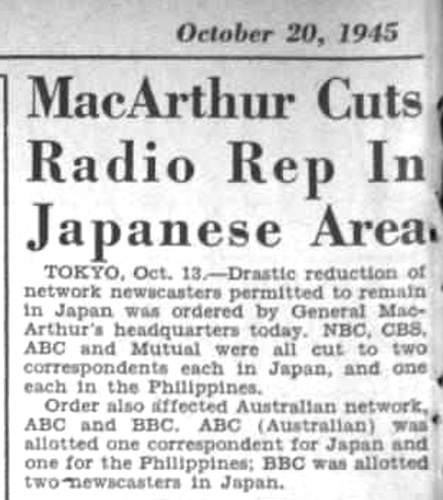
source: “MacArthur Cuts Radio Rep In Japanese Area”, The Billboard, Vol.57, No.42, October 20, 1945, p.4
- 「Pt.0 (はじめに)」
- 「Pt.1 (定速度と定振幅、電気録音黎明期)」
- 「Pt.2 (世界初の電気録音、Brunswick Light-ray、ラジオ業界の脅威)」
- 「Pt.3 (Blumlein システム、当時のRCAやColumbia、民生用における高域プリファレンスの萌芽)」
- 「Pt.4 (Vitaphone、Program Transcription、Electrical Transcription、Bell Labs / Western Electric 縦振動トランスクリプション盤)」
- 「Pt.5 (ベル研とストコフスキーのエピソード、横振動トランスクリプション、Orthacousticカーブ)」
- 「Pt.6 (アセテート録音機のカッターヘッド特性、高調波歪の論文、超軽量ピックアップ)」
- 「Pt.7 (圧電ピックアップとジュークボックス、定速度記録再生の試み)」
- 「Pt.8 (1942年 NAB 標準規格策定の歴史)」
- 「Pt.9 (大戦中〜戦後、LP登場前夜の状況について)」
の続きです。
This article is a sequel to
- “Things I learned on Phono EQ curves, Pt.0 (Intro)”,
- “Pt.1 (constant velocity/amplitude, early years of electrical disc recording)”,
- “Pt.2 (earliest electrical recordings, Brunswick Light-ray, Radio industry)”,
- “Pt.3 (Blumlein system, RCA and Columbia in the early 1930s, germination of treble pre-emphasis)”,
- “Pt.4 (Vitaphone, Program Transcription, Electrical Transcriptions, Bell/WE Vertical Transcription)”,
- “Pt.5 (Bell Labs = Stokowski episode, Lateral Transcription and Orthacoustic)”,
- “Pt.6 (Instantaneous Recorders, papers on distortion and lightweight pickup)”,
- “Pt.7 (piezo-electric pickups, jukebox, constant-amplitude recording)”,
- “Pt.8 (history of 1942 NAB Standards)”.
- and “Pt.9 (various situations in the 1940s)”.
毎回書いている通り、筆者自身の学習過程を記したものですので、間違いの指摘や異論は遠慮なくお寄せください。
As I noted in every part of my article, this is a series of the footsteps of my own learning process, so please let me know if you find any mistakes on my article(s) / if you have different opinions.
今回も相当長い文章になってしまいましたので、さきに要約を掲載します。同じ内容は最後の まとめ にも掲載しています。
Again, this article become very lengthy – so here is the summary of this article (the same contents are avilable also in the the summary subsection).
1942年暫定NAB規格は大戦中のため作業が中断したが、1947年から再び残る項目策定の作業が活発に行われた。
After the 1942 NAB Standards, the work had been suspended due to the wartime. But the work resumed in 1947 toward the adoption of the complete standards, discussing the rest of the standard items.
標準規格委員会の会合における議論の中で、1942年NAB標準規格の録音カーブは高域プリエンファシスが強すぎて、高域で歪みが多くなるため、改訂版規格ではプリエンファシスを弱めるべき、という意見が多数出されていた。しかも、具体的に、NABの100μsから、のちの1953年NARTB(すなわち 1954年 RIAA)と同じ75μsに下げるべきという意見が、1947年の議論の時点で出されていたことは特筆に値する。
During the Committe meetings and discussions, too much high-frequency pre-emphasis was critisized due to the distortion. Many engineers (committee members) claimed that the revised pre-emphasis should be lowered for better reproduction. Also, it is worthy of special mention that, even in 1947, many committee members claimed the 100μs pre-emphasis should be lowered to 75μs, that the 1953 NARTB Standards (thus 1954 RIAA Standards) would adopt a few years later.
1949年4月に開催されたNAB年次総会で標準規格委員会の会合が持たれ、改訂版NAB標準規格が承認された。業界で急速に普及しだした磁気テープ録音に関する規格策定がメインであった。一方、1942年暫定規格では承認が間に合わなかった、ディスク録音再生に関する追加項目も無事含められた。
NAB Recording and Reproducing Standards Committee meeting was held in April 1949, during the NAB Annual Meeting, and the revised 1949 Standards were adopted. The primary topic was the formulation of the standards for magnetic recording, that was rapidly diffused in the radio industry. Additional items for disc recording/reproducing, that were late for the tentative 1942 Standards, were also included in the 1949 Standards.
あれだけ高域プリエンファシスを下げるべきという議論が行われていたのに、1942年カーブがそのまま1949年カーブに引き継がれた。それは、磁気テープ録音規格の策定が急がれていたこと、そして、1949年NAB標準規格策定前の1948年6月に Columbia Long Playing Micgrogroove レコードが、1942年NAB録音カーブと類似したカーブを採用して登場したこと、が関係していると考えられる。
After all, the 1942 recording characteristics was carried over, kept unmodified, and adopted as a part of the 1949 NAB Standards, although there were some discussion on the “too much” high frequency pre-emphasis. This was highly probably because: (1) the Committee at the time was overwhelmed by busy works formulating the new recording medium – magnetic tape; and (2) before the final adoption of 1949 NAB Standards, Columbia proudly introduced the new type of disc medium for home use – LP (Long Playing Microgroove records), with very similar recording characteristics as 1942 NAB recording characteristics.
NAB標準規格委員会は、ASA(American Standards Association、アメリカ規格協会)とも連携し、各業界を通した規格策定を目指していたことが読み取れる。また、1947年の時点で、主に欧州の放送業界とも連携を始めており、トランスクリプション盤の世界的な規格統一を目指していたことも注目に値する。ただし、実際にそれが達成されるにはまだまだ時間を要した。
NAB Standards Committee, with the close relatonship with ASA (American Standards Association) that served as a liasion between NAB and other organization, aimed for the cross-industrial standardization. International standardization (of transcription records for broadcasting industry) was also kept in their mind, with frequent discussion with many stations, companies and organizations especially in Europe. However, it would took many more years until the standards were finally internationally uniformed.
Contents / 目次
10.1 Further Discussion toward revising NAB Recording and Reproducing Standards
本稿 Pt.8 でその経緯を細かくみてきたように、NAB (National Association of Broadcasters) の録音・再生規格委員会によって1942年6月に無事策定・採用された、放送局トランスクリプション盤用カーブ(1942 NAB カーブ)ですが、大戦中は作業が中断しました。そして戦後に入り、中断していた作業が1947年から継続されます。
As we have seen the details in the Pt.8 of my article, Recording and Reproducing Standards by NAB (National Association Broadcaster) was initially adopted in June 1942, then the Committee work suspended during the war. Then after the WWII (more precisely, since 1947), postponed work resumed.
1942年には記録周波数特性(録音カーブ)など、取り急ぎ16項目のみ策定されましたが、録音レベルの規定やS/N比、センターホールの同心度(偏心度)、用語集、その他の項目についての標準規格策定について、1947年から動き出します。
The 1942 Standards consisted of only sixteen items, including frequency characteristics for lateral/vertical disc recordings. Discussions of other items, such as recording level, signal-to-noise ratio, concentricity of center hole, glossary, etc., resumed in 1947.
前述の通り、1942年に正式承認された NAB Recording and Reproducing Standards は16項目から構成されていますが、興味深い資料を見つけました。
As I noted above, the officially adopted NAB Recording and Reproducing Standards (1942) consists of sixteen items. However, I have found an interesting documentation.
1944年に英国 Bernards Publishers, Ltd. が発行した小冊子「Manual of Direct Disc Recording」は、ディスク録音に関する基礎的な解説書で、その巻末に NAB標準規格が掲載されていますが、そこには16項目ではなく24項目が掲載されているのです。確かにこの小冊子でも「最初の16項目はすでに承認済で業界に通達されている」と書かれています。
A booklet entitled “Manual of Direct Disc Recording” was published by Bernards Publishers, Ltd. in 1944, Great Britain. It deals with the fundamentals of disc recording technology, and the NAB Standards is listed at the end of the booklet. Interestingly enough, it consists of twenty-four items, not sixteen items. Actually, this booklet reads: “the first sixteen of which have already been adopted and submitted to the industry”.
大戦中は作業が中断していたはずなのですが、1944年時点で、正式承認ではないにせよ、追加の8項目が存在したことを示す資料、ということになります。そして、戦時中にも細々と追加項目の議論が進んでいたことを示すことになります。
According to the NAB Reports articles we have read, the Committee work was suspended during the wartime. But this booklet shows the existence of additional eight items in the year 1944, although they were not yet officially adopted. Also, this proves that the Committee was working (although in very slow progress) even during the wartime.
これらの追加項目は、1947年に再開した議論で一部修正されたのち、最終的に1949年改定NAB標準規格に含まれることになります。
These additional items would eventually be modified and adopted as a part of the revised NAB Standards in 1949, after the resumption of the work since 1947.
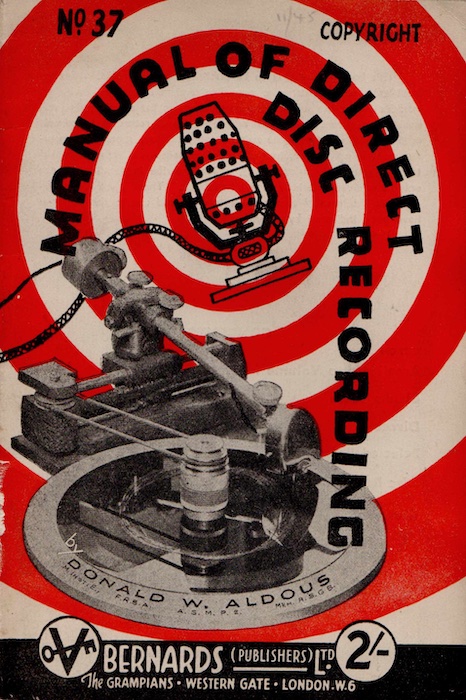
source: “Manual of Direct Disc Recording”, Bernards (Publishers), Ltd., 1944.
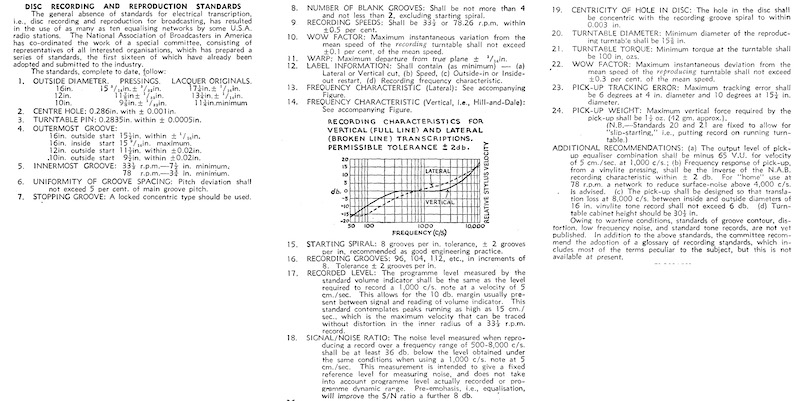
source: “Manual of Direct Disc Recording”, pp.35-37, Bernards (Publishers), Ltd., 1944.
巻末に掲載された1944年時点のNAB標準規格。1942年正式承認の16項目ではなく24項目となっている。
10.1.1 Audio Engineering, Oct. 1947
1947年9月14日〜16日、アトランティックシティで開催された NAB 年次総会において、NAB 録音・再生規格委員会の会議 (NAB Recording and Reproducing Committee Meeting) が 16日に開催されました。これは大戦前に行われていた議論の再開となります。
On September 14 to 16, 1947, NAB Annual Convention was held in Atlantic City. During the Convention, NAB Recording and Reproducing Committee met on Sep. 16, to reorganize for postwar activity.
Audio Engineering 1947年10月号 では、その会議の模様が報告されています。
October 1947 issue of Audio Engineering magazine reports on this first postwar meeting of the NAB committee.
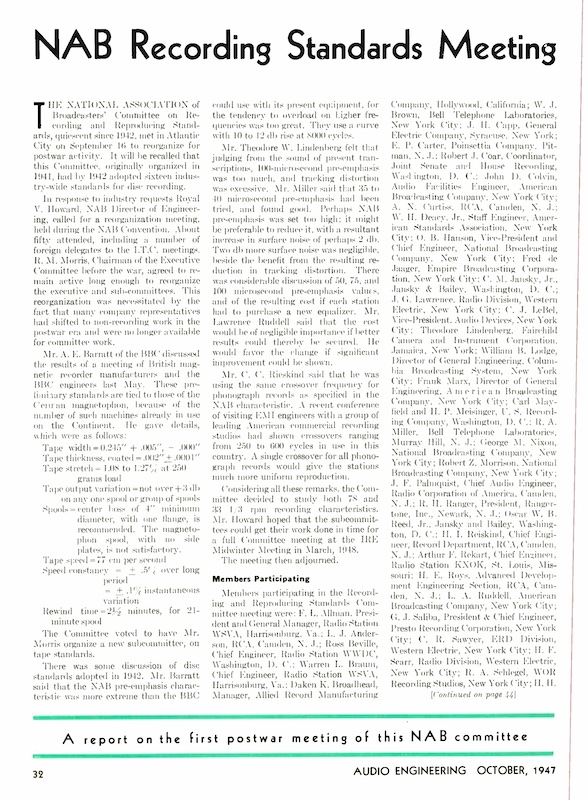
source: Audio Engineering, October 1947, Vol.31, No.9, p.32
戦後初めて開催された NAB 委員会会議の模様を伝えた記事
この会議では、1942年暫定企画にはなかった、磁気録音(テープ、ワイヤ)の規格についての議論に始まりました。BBC の A.E. Barrett 氏が、5月に行われた英国におけるテープレコーダ製造メーカとBBCエンジニアとの会合の結果を報告したのち、NAB としてもテープの標準規格の小委員会の設置が決められました。
The meeting started with the discussion of the magnetic recording (tapes and wires) standards, that was not considered when the provisional 1942 standards were adopted. Mr. A.E. Barrett of the BBC discussed the result of a meeting of British magnetic recorder manufacturers and the BBC engineers last May. Then NAB decided organizing a new subcommittee on tape standards.
その後、1942年に採択された NAB 録音・再生標準規格についての議論が行われました。まず、上述の Barrett 氏の意見です。
Along came some discussion of disc standards adopted in 1942. Mr. Barrett initiated the discussion.
There was some discussion of disc standards adopted in 1942. Mr. Barrett said that the NAB pre-emphasis characteristic was more extreme than the BBC could use with its present equipment, for the tendency to overload on lighter frequencies was too great. They use a curve with 10 to 12 db rise at 8,000 cycles.
1942年に採択されたディスク標準規格に関する議論がいくつか行われた。(BBC の)Barrett 氏は、NAB カーブにおけるプリエンファシス(高域増幅)は、BBC 現機材で可能なプリエンファシスよりも極端に強く、高周波数帯域でオーバーロードする傾向が強すぎる、と述べた。ちなみに BBC では 8,000Hz で 10dB〜12dB 上昇するカーブが採用されている。
NAB Recording Standards Meeting, Audio Engineering, October 1947, Vol.31, No.9, p.32本稿 Pt.9 のセクション 9.2.6 でも登場した「8,000Hz で 10dB 上昇する」という謎の録音カーブ、再び登場しました。ちなみに、前回も述べた通り、8,000Hz で 10dB 上昇するカーブには AES カーブ(に対応する録音カーブ)があり、10,000Hz では +12dB となります。再生側の時定数は 61.33μs (高域ターンオーバー周波数 2,595Hz) となり、のちの RIAA より少し浅めの増幅です。
Again, as we previously read “10-db boost at 8,000 cycles” in Pt.9 Section 9.2.6, this mysteriously mentions the “10 to 12 db rise at 8,000 cycles”. If it was correct, the time constant (for RC circuits) would be 61.33μs – treble turnover frequency at 2,595Hz – slightly less pre-emphasis than RIAA – looking similar to the recording characteristics for AES curve.
しかし、当該記事におけるこの表現は、実際のところ正確ではないと断言できます。この件については、のちほど再び触れます。
However, I am confident that this description is NOT correct. I will mention this later again.
続いて、Fairchild 社の Theodore Lindenberg 氏、さらに Bell Telephone Laboratories の R.A. Miller 氏も、高域プリエンファシスが強すぎる、という意見を述べました。
The next speaker was Mr. Theodore Lindenberg of Fairchild, followed by Mr. R.A. Miller of Bell Telephone Laboratories. Both expressed their opinions of the NAB Standards’ treble pre-emphasis being too high.
Mr. Theodore W. Lindenberg felt that judging from the sound of present transcriptions, 100-microsecond pre-emphasis was too much, and tracking distortion (note: this might precisely be “tracing distortion”) was excessive. Mr. Miller said that 30 to 40 microsecond pre-emphasis had been tried, and found good. Perhaps NAB pre-emphasis was set too high; it might be preferable to reduce it, with a resultant increase in surface noise of perhaps 2 db.
(Fairchild 社の)Theodore W. Lindenberg 氏は、現在のトランスクリプション盤の再生音から判断して、100μs のプリエンファシスは強すぎ、トラッキング歪(訳註: 正確には「トレーシング歪」のことでしょう)が強すぎる、と感じていると意見を述べた。また(ベル研の)Miller 氏は、30μs〜40μsのプリエンファシスで実験し、結果は良好であったと述べた。また、NAB(録音カーブにおける)プリエンファシスは強すぎるだろうから、プリエンファシスを若干弱めることが望ましい、ただしそれに伴ってサーフェスノイズが 2dB 程度増えることになるであろうが、とも述べた。
NAB Recording Standards Meeting, Audio Engineering, October 1947, Vol.31, No.9, p.32主に16インチトランスクリプション盤用に RCA/NBC Orthacoustic 〜 1942 NAB で採用されてきた高域プリエンファシスは RC 回路でいうところの時定数 100μs(10,000Hz で +16dB)ですが、これが過剰で、高域歪を招くから、もう少しゆるい高域プリエンファシスにすべき、という意見が両者に共通していることがわかります。
Treble pre-emphasis for RCA/NBC Orthacoustic (1939) and NAB Standards (1942) was the time constant of 100μs (for RC circuits), with +16dB rise at 10,000Hz. It was not bad for 16-inch transcription records, but both Mr. Lindenberg and Mr. Miller insists to revise the Standards, lowering this “too much” pre-emphasis, because of the high frequency distortion with the NAB recording characteristic.
さらに、放送局における、市販レコード再生の話へと移ります。
The discussion moves to another topic – reproduction of commercial phonograph records at broadcast stations.
Mr. C.C. Rieskind (note: this could be a typo of “H.I. Reiskind”, Chief Engineer, Record Department, RCA, Camden, N.J.) said that he was using the same crossover frequency for phonograph records as specified in the NAB characteristic. A recent conference of visiting EMI engineers with a group of leading American commercial recording studios had shown crossovers ranging from 250 to 600 cycles in use in this country. A single crossover for all phonograph records would give the stations much more uniform reproduction.
C.C. Rieskind(訳註: RCA レコード部門主任エンジニアの “H.I. Reiskind” 氏の間違いと思われます)は次のように述べた。「現在、市販用レコードを再生する際、自分は NAB カーブで再生している。」「最近、EMI のエンジニアと米国大手市販レコード用録音スタジオの面々による会合が持たれ、そこでは米国において使われているターンオーバー周波数は250Hz〜600Hzとまちまちであると判明した。」「全ての(市販用)レコードに対して単一のターンオーバー周波数を採用することで、放送局においてより均一な再生が可能になる。」
NAB Recording Standards Meeting, Audio Engineering, October 1947, Vol.31, No.9, p.32これらの意見を受け、さらに 78rpm(市販レコード)と 33 1/3rpm(トランスクリプション盤)の録音特性について、更に調査を行うことが決定されました。
In response to these comments and opinions, further studies on 78 rpms (commercial records) and 33 1/3 rpms (transcription records) was to be conducted.
Considering all these remarks, the Committee decided to study both 78 and 33 1/3 rpm recording characteristics. Mr. Howard hoped that the subcommittees could get their work done in time for a full Committee meeting at the IRE Midwinter Meeting in March, 1948.
これらの意見を鑑み、委員会の決定により、78回転盤と 33 1/3回転盤の録音特性についてさらなる調査が行われることとなった。(NAB技術ディレクタの)Howard 氏は、小委員会が作業を進め、1948年3月の IRE ミーティングにおける委員会までに間に合うことを望む、と述べた。
The meeting then adjourned.
本会合はここで散会となった。
NAB Recording Standards Meeting, Audio Engineering, October 1947, Vol.31, No.9, p.32つまり、ラジオ放送局用トランスクリプション盤の標準規格である NAB Standards ですが、同時に市販用レコードの規格についても議論の対象としていたことが伺えます。実際、市販レコードはラジオ番組でかけられることも多く、すでに(暫定版ながら)標準規格を策定しているラジオ業界から、レコード業界や録音再生機機製造メーカに対して、市販用レコードに対しても同様の標準化を働きかけたい、という強い意志がみてとれます。
This article tells us that, NAB Standards Committee, aiming for the standardization of electrical transcriptions in the radio industry, also was trying to discuss the standards for the commercial disc records. As a matter of fact, commercial 78rpm records were frequently played at radio stations, and they wished for some standardization also in the commercial record field.
本稿 Pt.8 セクション 8.1.5 で紹介した Communications 誌の記事にあった「トランスクリプション盤の規格と市販のレコード盤の規格を、可能な限り相互に関連づける」という取り組みが、LP登場の直前のこのタイミングで、ついにスタートを切ったということになります。
So, an attempt to “correlate eletrical transcriptions and phonograph record standards whereever possible”, as we already have seen in the Pt.8 Section 8.1.5, was about to get started at this point, just before the advent of Long Playing microgroove records.
10.1.2 NAB Reports, August 4, 1947
以上、Audio Engineering 誌上に(委員会開催後に)掲載されたレポート記事をみてきたわけですが、当然ながら 本稿 Pt.8 で大量に引用して読んだ、NAB Reports においても、1947年の録音・再生規格委員会の動きについて、より詳しい記載があるのを確認できます。上でみた Audio Engineering 誌のレポート記事との微妙なニュアンスの違いもみてとれるので、どちらがより正確に描写しているのか、考えてみるのも興味深いです。
So far we have read the report article in the Audio Engineering magazine, after the Committee Meeting actually took place. But of course, we can find many more information about the activities of the Recording and Reproducing Standards Committee in the NAB Reports, that we have read so many articles in, like we did in the Pt.8 of my entire article. It is interesting to see the subtle difference between the Audio Engineering article and the reports told in NAB Reports.
ともあれ、1947年の NAB Reports 誌に掲載されたレポートを、時系列にみていきましょう。
Anyway, let’s study what was told in the NAB Reports’ reports, in time series.
まずは 1947年8月4日号 に掲載された、9月16日開催のアトランティックシティにおける会合開催が決定したことを伝える記事です。
The first article is on the August 8, 1947 issue of NAB Reports. It reports the Standards Committee meeting will be held during the NAB Annual Meeting in Atlantic City, September 16.
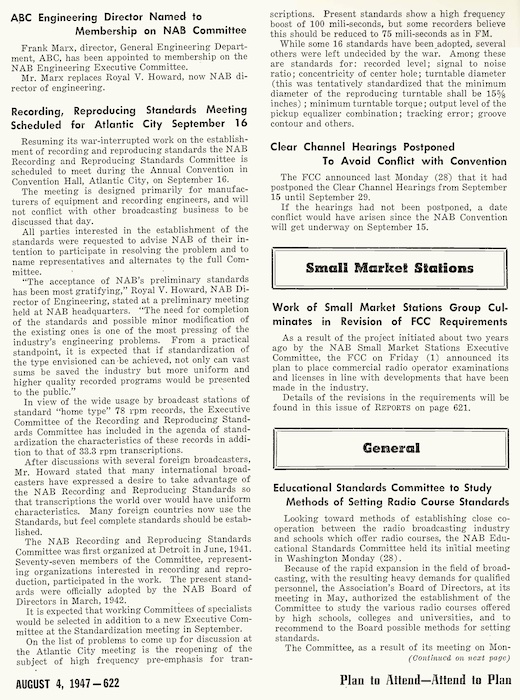
source: “NAB Reports, Vol.15, No.31, August 4, 1947”, p.622
1947年9月16日に「録音・再生規格委員会」会合が開催予定であることを伝える記事
Recording, Reproducing Standards Meeting Scheduled for Atlantic City September 16
録音・再生規格委員会会合、アトランティックシティで9月16日に開催決定
Resuming its war-interrupted work on the establishment of recording and reproducing standrads the NAB Recording and Reproducing Standards Committee is scheduled to meet during the Annual Convention in Convention Hall, Atlantic City, on September 16.
大戦により中断していた、録音・再生に関する標準規格策定作業を再開すべく、1947年9月16日にアトランティックシティのコンヴェンションホールで開催される年次会合において、NAB 録音・再生規格委員会の会合が持たれることとなった。
The meeting is designed primarily for manufactures of equipment and recording engineers, and will not conflict with other broadcasting business to be discussed that day.
本会合は、主に録音再生機機の製造メーカおよび録音エンジニアのために計画されたものであり、同時に当日行われる他の放送事業に関する議論(会合)とはバッティングしないようにされる。
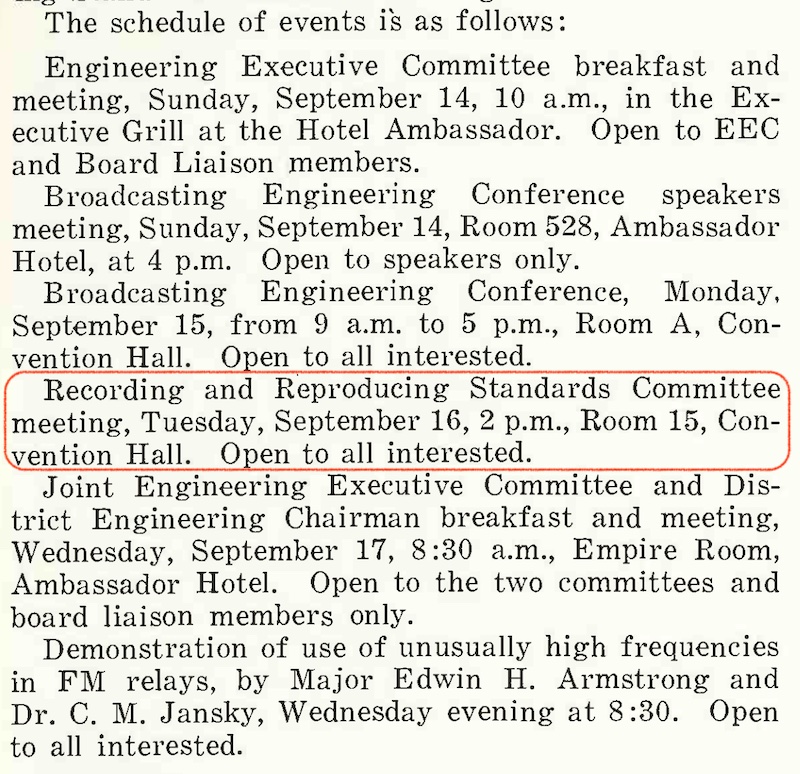
source: “NAB Reports, Vol.15, No.36, September 8, 1947”, p.729
1947年NAB年次総会中に開催される技術部門の会合スケジュール
All parties interested in the establishment of the standards were requested to advice NAB of their intention to participate in resolving the problem and to name representatives and alternates to the full Committee.
規格策定に関心のある全関係者に向けて、問題解決作業への参加意思をNABに伝え、全委員会の代表者と補欠者を指名するよう、要請したところである。
“The acceptance of NAB’s preliminary standards has been most gratifying,” Royal V. Howard, NAB Director of Engineering, stated at a preliminary meeting held at NAB headquarters. “The need for completion of the standards and possible minor modification of the existing ones is one of the most pressing of the industry’s engineering problems. From a practical standpoint, it is expected that if standardization of this type envisioned can-be achieved, not only can vast sums be saved the industry but more uniform and higher euqlity recorded programs would be presented to the public.”
「NABの暫定規格が受け入れられたことは非常に喜ばしいことである」と、NAB本部で開催された準備会合において、NAB 技術ディレクタの Royal V. Howards 氏が述べている。「標準規格を完成させ、既存の(暫定)規格に修正を加えることは、業界における技術的な問題の中で最も急を要するものの1つである。現実的な視点から言うと、標準化の実現により、業界は莫大な費用を節約できるようになるだけではなく、より均一で、より質の高い録音放送が公衆に提供可能になる、と期待される」とも述べた。
NAB Reports, August 4, 1947, Vol.15, No.31, p.622上記から、規格標準化とは、単に「録音・再生規格を統一して、高音質の再生を可能にする」のが目的ではなく、「コスト削減」の目的もあること、いやむしろ、コスト削減の方がより喫緊の課題と受け止められていたことが読み取れます。
It surely tells us that the standardization is for “reduction of cost”, as well as for “uniform high quality delivery of music” – or we might say that “reduction of cost (money/labor)” is the most important aspect of the standardization in the industry.
それはそうですよね。あらゆる録音カーブが乱立している(しかも個々のカーブに関する正確な技術情報が公開されていなかった)状態では、いかなるカーブでも再生可能にするためには、再生機器側でそれなりの追加コストがかかる、と容易に想像できます。
It all makes sense – so many variations of recording characteristics were used at various recording facilities (and what was worse, virtually no precise technical information about the characteristics were disclosed), that forced broadcasting studios to spend extra cost for the reproducers and peripherals in order to compensate any transcription / shellac records for better playback.
また、当時の録音カーブは、現在の可変カーブフォノイコのように「ターンオーバー周波数」と「ロールオフ」を変化させればよい、なんて単純なものではなく、録音カーブ実現のための回路もバラバラで、同じパラメータでもカーブの傾斜が微妙に異なるものすらありました。そういった煩雑な機材導入コスト・作業コストを軽減することで、放送局に余計な出費をさせず、放送局の日々の業務をよりスムーズにする、そういう来るべき未来を目指していたということでしょう。
Also, as I have written many times in the past articles, recording equalizers at that time varied much – different circuits (LRC/LR/RC) for a specific curve, difficulties changing parameters without soldering. It was NOT that the recording characteristic was easily modified like archival variable phono EQ preamplifiers. So the engineers were thinking that the standardization of recording/reproducing characteristics would lead to the future without any complicated trials and errors, along with vast amount of cost savings for buying equipments, experimentation and procedures, resulting in smooth broadcasting operation daily at the stations.
In view of the wide usage by broadcast stations of standard “home type” 78 rpm records, the Executive Committee of the Recording and Reproducing Standards Committee has included in the agenda of standardization the characteristics of these reords in addition to that of 33.3 rpm transcriptions.
家庭用(市販用)として標準的な78回転レコードも、放送局で広く使用されていることから、録音・再生規格委員会の執行委員会は、33 1/3回転のトランスクリプション盤に加え、78回転レコードの特性も標準化会合の議題とした。
NAB Reports, August 4, 1947, Vol.15, No.31, p.622上記から、トランスクリプション盤の規格統一のみならず、市販のレコードについても調査し、規格統一に向けて働きかけたい意思が読み取れます。
The above lines shows the Committee’s desire to study the characteristics of commercial 78rpm records (and the standardization of them, if possible), along with the standardization of transcription records in the broadcast industry.
After discussions with several foreign broadcasters, Mr. Howard stated that many international broadcasters have expressed a desire to take advantage of the NAB Recording and Reproducing Standards so that transcriptions the world over would have uniform characteristics. Many foreign countries now use the Standards, but feel complete standards should be established.
海外の放送局数社との議論ののち、NAB の録音・再生規格を活用し、世界中のトランスクリプション盤の特性を統一したい、という意向を多くの海外放送局が示しており、また現在、多くの外国においてこの規格が使われているが、より完全な規格を策定すべきであると考えている、と Howard 氏は述べた。
The NAB Recording and Reproducing Standards Committee was first organized at Detroit in June, 1941. Seventy-seven members of the Committee, representing organizations interested in recording and reproduction, participated in the work. The present standards were officially adopted by the NAB Board of Directors in March, 1942.
NAB Reports, August 4, 1947, Vol.15, No.31, p.622あわせて、「世界中のトランスクリプション盤の規格統一に向けて」という、さらに大きな目標もみてとれます。実際にそれが実現するには、まだまだ時間を必要としたわけですが。
Such big goal as “the desire to have uniform characteristics among all transcriptions worldwide” can be read, too, although it took long years until this goal be accomplished.
NAB 録音・再生規格委員会は、1941年6月にデトロイトで初めて組織され、録音・再生に関心を持つ団体を代表する77名のメンバが参加した。現在の規格は1942年3月に NAB 理事会により正式に採択されたものである。
It is expected that working Committees of specialists would be selected in addition to a new Executive Committee at the Standardization meeting in September. On the list of problems to come up for discussion at the Atlantic City meeting is the reopening of the subject of high frequency pre-emphasis for transcriptions. Present standards show a high frequency boost of 100 mili-seconds (note: this should be 100 micro-seconds), but some recorders believe this should be reduced to 75 mili-seconds (75 micro-seconds) as in FM.
9月の標準化会合では、新執行委員会の選出に加え、専門家による作業委員会が選出される予定となっている。アトランティックシティの会合で議論される予定の議題として、トランスクリプション盤におけるプリエンファシス(高域増幅)のトピックの再開があげられる。現在の(1942年NAB)規格では、高域ブーストは 100ms(訳註: これは「100μs」が正しいです) だが、FM 放送で用いられている 75ms(訳註:「75μs」の誤記)にさげるべきだ、と主張する録音エンジニアもいる。
While some 16 standards have been adopted, several others were left undecided by the war. Among these are standards for: recorded level; signal to noise ratio; concentricity of center hole; turntable diameter (this was tentatively standardized that the minimum diameter of the reproducing turntable shall be 15% inches) ; minimum turntable torque; output level of the pickup equalizer combination ; tracking error; groove contour and others.
(1942年の暫定規格では)16項目が採用されたが、残る項目は大戦によって未解決のままとなっている。それら未決定項目には以下のようなものがある。録音レベル、S/N比、センターホールの同心度(偏心度)、ターンテーブルの直径(再生用ターンテーブルの最小直径を15 5/8 インチとすることが暫定的に標準化された)、ターンテーブルの最小トルク、再生用イコライザの組み合わせによる出力レベル、トラッキングエラー、音溝の形状、など。
NAB Reports, August 4, 1947, Vol.15, No.31, p.622そしてさきほど Audio Engineering 誌の記事でみたように、「市販用レコードの規格についての調査」「1942年NABカーブのプリエンファシスは強すぎるのではないか、という議論」が、会議開催前のこのタイミングですでに議題としてあがっています。
Also, as we already have seen in the Audio Engineering magazine’s article, “agenda of standardization of the characteristics of home type 78 rpm records” is mentioned here. Also the engineers’ concern about too much high frequency pre-emphasis on the 1942 NAB Standards (RCA/NBC’s Orthacoustic) is expressed here, before the actual meeting.
10.1.3 NAB Reports, September 29, 1947
続く NAB Reports 1947年9月29日号 に、9月16日のアトランティックシティでの会合における議論の模様が、上述の Audio Engineering 誌の記事より極めて詳細に解説されています。以下それらをみていきましょう。
The following issue, September 4, 1947 issue of NAB Reports reports the details of the discussion at the Committee meeting held during the Annual Convention in Atlantic City on September 16. Let’s take a closer look.
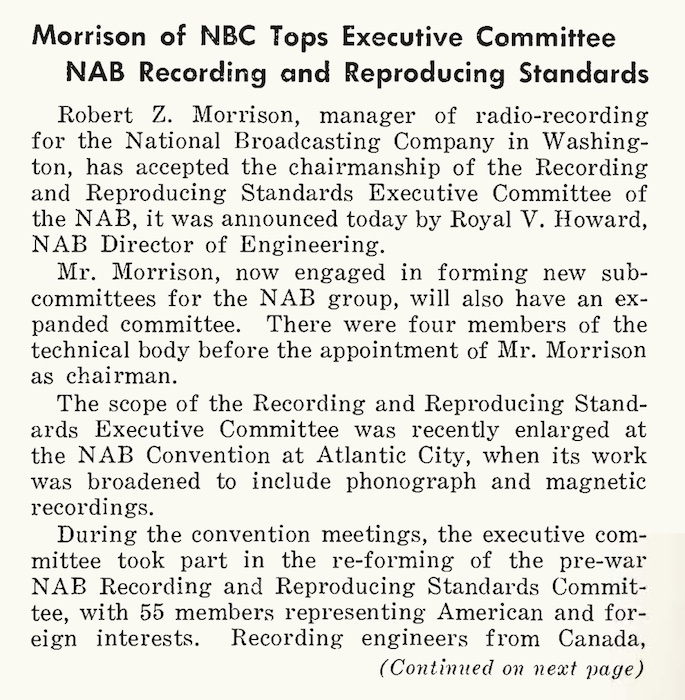
source: “NAB Reports, Vol.15, No.39, September 29, 1947”, pp.792-794
1947年9月16日に開催された「録音・再生規格委員会」会合の模様を詳細に伝える報告記事
訳註: 「Robert Z. Morrison」とあるのは「Robert M. Morris」の誤記で、NAB Reports 1947年10月6日号 p.822 にお詫びが掲載されています。以下の文章では私によって誤植を修正しています。
note: “Robert Z. Morrison” is a typo of “Robert M. Morris”, as mentioned in the Oct. 6, 1947 issue of NAB Reports, p.822; his name in these quotes are already corrected by me.
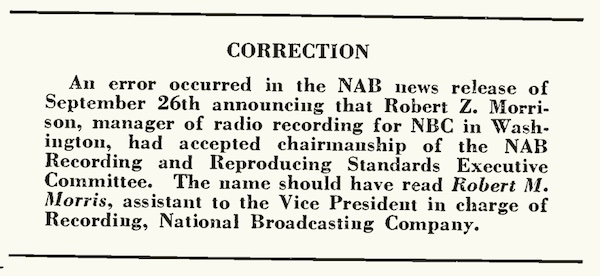
source: “NAB Reports, Vol.15, No.40, October 6, 1947”, p.822
9月の記事において、Robert M. Morris 氏を Robert Z. Morrison と誤って記載したことの謝罪訂正欄
Morris of NBC Tops Executive Committee; NAB Recording and Reproducing Standards
NBC の Morris 氏、執行委員会のトップに就任; NAB 録音・再生標準規格
Robert M. Morris, assistant to the Vice President in charge of Recording, National Broadcasting Company, has accepted the chairmanship of the Recording and Reproducing Standards Executive Committee of the NAB, it was announced today by Royal V. Howard, NAB Director of Engineering.
NBC 社の副社長補佐(録音担当)である Robert M Morris 氏が、NAB 録音・再生規格執行委員会の委員長への就任を承諾した。このことは NAB 技術ディレクタの Royal V. Howard 氏によって本日発表されたものである。
Mr. Morris, now engaged in forming new sub-committees for the NAB group, will also have an expanded committee. There were four menbers of the technical body before the appointment of Mr. Morris as chairman.
Morris 氏は現在、NAB 分科会の設置に従事しているが、同時に委員会の規模を拡大することとなった。Morris 氏の委員長就任前は、技術委員会のメンバは4人であった。
The scope of the Recording and Reproducing Standards Executive Committee was recently enlarged at the NAB Convention at Atlantic City, when its work was broadened to include phonograph and magnetic recordings.
録音・再生規格委員会の執行委員会のスコープは、アトランティックシティの NAB の大会で拡大された。そのスコープはディスクレコードと磁気録音(テープ録音)の標準化を含むものとされた。
During the convention meetings, the executive committee took part in the re-forming of the pre-war NAB Recording and Reproducing Standards Committee, with 55 members representing American and foreign interests. Recording engineers from Canada, Mexico, Cuba, Portugal, Russia, South Africa, India, the United Kingdom, and the International Broadcast Organization (OIR) of Brussels, Belgium, were present at the meetings.
大会の会合において、執行委員会は戦前のNAB録音・再生規格委員会の再編成に参加し、(アメリカ)国内外を代表する55の委員が集まった。カナダ、メキシコ、キューバ、ポルトガル、ロシア、南アフリカ、インド、英国の録音エンジニアに加え、ベルギー・ブリュッセルの OIR (Organisation Internationale de Radiodiffusion, International Broadcast Organization, 国際放送機関) も出席した。
NAB Reports, September 29, 1947, Vol.15, No.39, pp.792-794米国に限らず、世界中のエンジニアが、NAB標準規格の動きに強い関心を持っていたことをうかがわせます。
It is very interesting that all the engineers from all around the world had a keen interest in the NAB Standards.
The committee, called to order by Royal V. Howard, NAB Director of Engineering, heard a report by Mr. Robert M. Morris of the National Broadcasting Company, the chairman of the R&RS Executive Committee, on the activities of his committee and the present status of the standards. Explaining the process leading up to the present 16 adopted NAB technical standards, Mr. Morris detailed the work that had been done on the more controversial matters. The controversial items upon which they had not reached agreement were then distributed to the full committee.
NABの技術ディレクタである Royal V. Howard 氏によって開会された委員会は、録音・再生規格委員会の委員長である Robert M. Morris 氏から、委員会の活動と、標準化の現状について報告を受けた。Morris 氏は、現在採択されている16のNAB技術基準に至る過程を説明し、より論議を呼ぶことになる事項についての作業について詳細に説明した。その後、論議が多く合意に至らなかった項目については、全委員会に配布された。
Elucidating, Mr. Morris said: “There was simply not enough time in 1942 with the pressure of war work on the members of the committee to complete all their work. It is most regrettable — I have regrettedit many times — that we didn’t have one more month in which to work, because I am satisfied that in that time we could have completed and adopted all the re-maining standards, with the possible exception of groove shape. We thus would have had five years progress toward more complete standardization.”
Morris 氏は次のように説明した。「1942年当時は戦時下労働のため、委員会メンバが全作業を完成させるだけの時間が単純になかった。これは非常に残念なことであった — 私は何度も後悔した — あと1ヶ月あれば、溝形状を除く残り全ての規格項目を完成させ、採用までこぎつけられたはず、と思うからだ。そうすれば、完全な標準化に向けて5年早く進展していたはずだからだ。」
NAB Reports, September 29, 1947, Vol.15, No.39, pp.792-794その後、BBC ニューヨークオフィスの A.E. Barrett 氏から、欧州における磁気録音(テープ)についてのレポートがありました。ドイツのマグネトフォン (Magnetophon) が欧州の放送局で既に広く行われており、ドイツの標準規格に合わせてテープ幅、テープ張力、テープ速度、ワウファクター、スプール径、応答周波数特性、テープ巻取りに要する時間、などについて、1947年5月にロンドンで行われた会合における議論が紹介されました。本稿ではディスク録音再生にトピックを絞っているため、この詳細は割愛します。
Following was a report by A.E. Barrett of BBC New York office, regarding magnetic recordings in Europe. German Magnetophon was widely used and many European broadcasting stations adopts Magnetophon standards. Also Mr. Barret introduced several topics conducted at the London meeting on magnetic recordings in May, including tape width, stretch ratio, tape speed, wow factor, spool center boss diameter, frequency response characteristics, re-winding speed, etc. This article of mine simply focuses on the history of disc recording, so the detail is ommited here.
BBC の Barrett 氏は続いて、BBC で行われているディスク録音実験研究について報告をしています。
Mr. Barrett of BBC New York then discusses the experimental work that BBC had been doing on disc recordings, as quoted below.
Mr. Barrett then discussed the experimental work that BBC had been doing on disc recordings, assuring the group that it was their desire to cooperate with NAB in its standardization work. “They have found,” he stated, “that the present NAB characteristics, when used with high-grade equipment, give excellent results. Because of the high recording level of the upper frequencies, a better signal to noise ratio is obtained than with the BBC characteristics, which have a 75 micro-second characteristic, i.e. up about 10 db over the base level. However, it was their belief that the advantages of the NAB characteristic are lost when a lower grade equipment is used, as the overall recording level must be reduced to avoid distortion resulting directly or indirectly from conditions prevailing in the upper frequencies. This reduction in level may also give rise to noise in the lower frequencies if there are mechanical imperfections in the replay turntable.”
Barrett 氏は、BBC が行ってきたディスク録音の実験研究について説明し、BBC が NAB の標準化作業に協力することを望んでいる、と断言した。また Barrett 氏は次のように述べた。「現在の NAB 特性は、高級な装置で使用すると、素晴らしい結果が得られることがわかった。(NAB 記録特性では)高域の録音レベルが非常に高く、BBC が採用している 75μs特性(すなわちベースレベルに対して +10dB)に比べて良い S/N 比が得られている。しかし、低グレードの機器で使用した場合、NAB 記録特性のアドバンテージが失われる。高域の記録状況から直接的・間接的に生じる歪を避けるために、全体の録音レベルを下げる必要があるからだ。この録音レベルを下げることにより、再生用ターンテーブルに機械的な欠陥がある場合、低周波のノイズを増加させる可能性がある、と、BBC は考えている。」
“It is our opinion,” Mr. Barrett said, “that if any degree of standardization is to be achieved, all variables in a system must be held within close tolerances. By that I mean the diameter of reproduction, sapphires, cutter-heads, etc.”
Barret 氏はさらにこう続けた。「なんらかの標準化を実現するためには、システム内の全ての変数が許容範囲内に収められなければならない、これが我々の考えだ。つまり、再生装置やカッターヘッドのサファイア針の直径のことだ。」
NAB Reports, September 29, 1947, Vol.15, No.39, pp.792-794この文章における「75μs(ベースレベルに対して +10dB)」の箇所は、正確な表現ではない、と考えます。BBC が 1950年に発行した書籍 “BBC Recording Training Manual” によると、BBC でトランスクリプション盤 (33 1/3回転)向けに使用されている記録特性では、確かに(1,000Hz を基準として)10,000Hz においては約 +10dB となっていますが、これは時定数 75μs によって得られるカーブではありません。50μs の間違いと思われます。
I don’t think this line “75 micro-second characteristic” is technically correct. According to the “BBC Recording Training Manual”, published in 1950, the graph of the recording characteristic for BBC’s Transcription (33 1/3rpm) surely shows +10dB rise at 10,000Hz (compared with 1,000Hz), while it is not obtained with the 75μs pre-emphasis – it should be 50μs.
一方、本稿冒頭で見た Audio Engineering 誌の記事 に書かれていたのは、「8,000Hz で 10dB〜12dB 上昇するカーブ」というものでした。しかし、下のグラフをみる限り、そうではありません。
On the other hand, the article on the Oct. 1947 issue of Audio Engineering magazine as I already mentioned above reads: “a curve with 10 to 12 db rise at 8,000 cycles” – which does not match with the graph below.
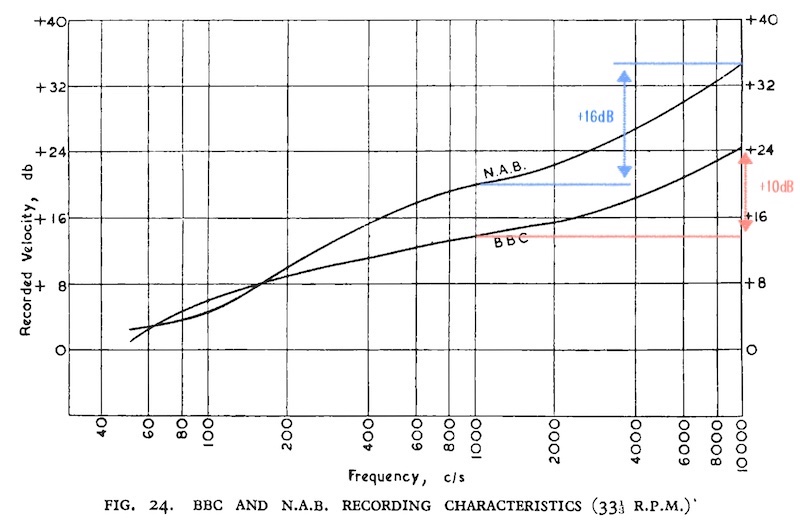
source: “BBC Recording Training Manual”, p.35 (1950)
BBC 社員教育向けを主として発行された1950年発行の書籍に掲載された、NAB カーブと BBC カーブ(共にトランスクリプション盤用)のグラフ
この謎に満ちた BBC カーブでは確かに、1,000Hz を基準として、10,000Hz では約 +10dB のプリエンファシスとなっていることが確認できる。
From the book published by BBC, primarily for employee training.
The mysterious BBC curve surely shows +10dB rise at 10,000Hz, compared with 1,000Hz
つまり、NAB Reports の記事を執筆した人は「+10dB at 10,000Hz のカーブは 50μsではなく 75μs である」と誤解し、Audio Engineering 誌の記事を執筆した人は「1,000Hz に対する比較を 10,000Hz で行う代わりに 8,000Hz で行う」と誤解した、つまり両者ともに間違えて記事を書いた、ということになるでしょうか。
After all, a writer of NAB Reports mistook 50μs for 75μs for +10dB rise at 10,000Hz, while another writer of Audio Engineering mistook 8,000Hz for 10,000Hz to compare with 1,000Hz – both writers misunderstood these things and wrote the articles.
まぁ仕方ないですよね。技術解説記事ではなくて、会議のレポート記事ですから、執筆者が必ずしも技術的背景を持ち専門知識を有しているとは限りませんから。
It can’t be helped that both misunderstood – these two articles are just reports, not technical articles. Not all report writers may fully understand the every detail of the technical topics.
続く Rangertone 社の R.H. Ranger 氏による、磁気録音に対する意見(本稿では割愛)ののち、ついに、ディスク録音における高域プリエンファシスについての議論が始まります。口火を切ったのは Fairchild 社の Lindenberg 氏でした。
Then R.H. Ranger of Rangertone discussed his thought on magnetic recording (omitted here), followed by the controversial discussion on high frequency pre-emphasis for disc recording. Mr. Lindenberg of Fairchild initiated the discussion:
One of the most controversial points of the recording standards previously adopted, that of the high frequency pre-emphasis characteristics, was then opened for discussion. Leading off this discussion was Mr. Theodore Lindenberg of Fairchild Camera and Instrument Corporation who said:
前回採択された標準規格の中で、最も議論を呼んだ点のひとつである、高域プリエンファシスの特性についての議論が行われた。まず議論を開始したのは Fairchild Camera and Instrument 社の Theodore Lindenberg 氏であった。
“I have had the feeling for some time that the high frequency uplift is a little bit overdone. In our present day assembly the greatest thing to my mind is the heavy level of transcriptions. I think that we should consider a decrease in the high frequency pre-emphasis.”
「高域プリエンファシスの盛り上がりが少し過剰な気がする、というのは、私が常々感じていることだ。本日の会合において、脳裏に浮かぶ最大関心事は、トランスクリプション盤の記録レベルが高すぎることだ。高域プリエンファシスの低減を検討すべきだ。」
NAB Reports, September 29, 1947, Vol.15, No.39, pp.792-794続いて、ベル研の Miller 氏が意見を述べます。
Mr. Miller of Bell Labs then express his thoughts:
In this connection, Mr. R.A. Miller of Bell Telephone Laboratories concurred, for he elaborated that, “today Bell Laboratories, as an apparatus designed of equalizers, was being requested continuously to put as many as 24 to 27 restoring networks in their equalizers, and that, therefore, there must be considerable agreement with the present curve and that they generally feel that the rise at the high end is too much for good wide band reproduction.” It was his belief that “the attempt to get a little bit less noise has certainly introduced a great many modulation by-products on a very wide frequency band system. This is very much more objectionable than the slight decrease in the amount of noise.”
これに関連して、ベル研の R.A. Miller 氏も同意見を述べた。「今日、ベル研究所では、再生用イコライザ設計を行う組織として、24から27もの再生用ネットワークをイコライザに含めるように継続的に要求されている。このような(混乱した)状況であるから、したがって、現在のカーブ(の標準化)にかなりの合意があるはずで、かつ現在の高域プリエンファシスは、優れた広帯域再生には過剰であると思われているはずである。」 そして彼の考えとして次のように述べた。「ノイズを少しでも減らそうとする試み(による、過剰な高域プリエンファシス)は、広帯域再生において非常に多くの変調に関する副産物をもたらしてしまったことは確かである。これはノイズの量が減るよりも、非常に不愉快なものである。」
NAB Reports, September 29, 1947, Vol.15, No.39, pp.792-794そうなんです。私が読みたい、知りたいと思っていたのは、このような専門家による議論です。なぜ RIAA カーブに落ち着いたのか、なぜ NAB カーブや Columbia カーブが最終的に残らなかったのか、そういった技術的な議論の経緯です。1942年NABカーブ策定の時には、あまり表に出てこなかった「当事者の生の声」ですが、今回の1949年改訂に向けた作業に際しては、こうやって意見がバッチリ読めるので、胸の空く思いです。
This is it! Such discussion report is what I wanted to read – technical discussion by engineers and specialists, that indirectly tells us the historical background of why NAB curve and Columbia curve finally disappeard; why RIAA curve was finally adopted both for transcriptions and commercial discs. Such “fresh voice” cannot be found on the articles regarding 1942 NAB standardization – I feel much relieved to find these transcription of the real discussion toward the 1949 standardization.
そして、執行委員会の委員長である Morris 氏は、白熱する議論を収めるべくコメントします。規格への遵守の重要性(すなわち、頻繁に規格を変更することへの懸念)が語られています。
Then Mr. Morris, the chairman of the Recording and Reproducing Executive Committee, pointed out the importance of the adherence (i.e. his concern about rapidly changing the standards frequently).
Mr. Morris then pointed out that, “while many believed that the high frequency pre-emphasis had been too high, the adherence to the NAB standards for electrical transcriptions had been good” and that he “did not know of any major manufacturer of records who was intentionally departing from the standard. However, all records played on broadcast stations are not transcriptions.”
委員長の Morris 氏は次のように指摘した。「確かに、高域プリエンファシスが強すぎるという意見が多くみられたが、トランスクリプション盤用NAB規格はこれまでよく遵守されてきた。」「また、意図的に規格を逸脱している大手レコードメーカを知らない」「その一方、放送局で再生されるレコードは、トランスクリプション盤が全てではないのも事実だ。」
Following an extensive discourse on the high frequency pre-emphasis, Chairman Howard read a letter from James Rockwell of Crosley which pointed out that they have investigated the recording and playback characteristics for various response curves such as NAB, Orthacoustic, lateral and vertical shellac records, etc., as well as the transitory distortion involved and find that many of the slightly different characteristics could be combined, thus reducing the complexity and cost of recording and playback equipment with no impairment of performance.
高域プリエンファシスに関する幅広い討議に続いて、Howard 議長は Crosley 社の James Rockwell 氏からの手紙を読み上げた。その手紙によると、Crosley 社が NAB / Orthacoustic / 横振動シェラック / 縦振動シェラック / その他のさまざまな録音・再生特性、およびそれに関連して過渡歪についても調査したとのこと。その結果分かったのは、類似する特性は1つにまとめることができ、録音・再生機器の複雑性やコストを軽減でき、音質面への副作用もないというのである。
After long and technical discussion on the problems of modifying recording standards without loss to the industry from present libraries, Chairman Howard instructed the Committee to give due consideration to this point.
録音規格を修正し、かつ(ラジオ)業界の現在保有する音源ライブラリが業界に損失を与えない(訳註: 古い規格で録音された盤が新しい規格で再生できない、などのことと思われます)か、この問題について長時間に渡り技術的な議論が行われたのち、Howard 議長は委員会に対し、この点について十分な検討を行うよう、指示を行った。
NAB Reports, September 29, 1947, Vol.15, No.39, pp.792-794この Crosley 社の Rockwell 氏の話が、具体的に何を指しているのかは分かりません。しかし、来たる AES カーブの様に「類似する録音カーブの折衷案としての統一再生カーブ」の話、すなわち「どんな記録特性の盤でもそこそこ満足して聴けるような再生カーブ」の話なのかもしれません。または、各社で非公開のまま使われている各種録音カーブを分類して、類似したもの同士をカテゴライズした、という話かもしれません。
I have no idea what Mr. Crosley of Rockwell really meant to say. But it could be some sort of “a unified reproducing characteristic as a compromise” like the AES curve; or it could be the work of rough categorization of many “proprietary” recording characteristics used by various labels and facilities.
The group then went into a discussion of the establishment of reproducing characteristics and the group brought out the point that the recording characteristics were not nearly as important as the reproducing standards and that they would like to see this reproducing restoration network be as simple as possible. If this could be done, they said, it would be possible to standardize both 78 and 33 rpm with only one filter. In this manner a simple resistance condenser filter could be used and, upon motion by Chariman Howard, the Committee agreed to endeavor to standardize on one characteristic for all disc recordings.
その後、再生特性策定についての議論に入った。この中で「録音特性は再生特性ほど重要ではない」「再生特性を実現する補正ネットワーク(フォノイコ)は、可能な限りシンプルにすべきだ」といった論点が出された。これが実現できれば、シンプルなRC回路によるフィルタを使えることになり、78回転も 33 1/3回転も1種類のフィルタで標準規格化できることになる、というのである。委員会は、Howard 議長の発案である「全てのディスク録音を一つの特性で統一するよう努力する」ことに同意した。
NAB Reports, September 29, 1947, Vol.15, No.39, pp.792-794「再生用フォノイコをシンプルにすべき」という意見は、本稿 Pt.5 セクション 5.2.2 でみた Orthacoustic 特性の解説記事の一文、「録音特性の実現、再生特性の実現を、可能な限りシンプルかつ廉価に行いたい」を引き継ぐものです。同時に、上の NAB Reports Aug. 4, 1947 のセクションでも述べた「コスト削減」という側面にも関連しています。また、のちの AES 再生カーブ策定同様、「再生カーブ規定の方が(録音カーブ標準化より)重要である」という意見も読み取れます。
The phrase “reproducing restoration network be as simple as possible” surely inherits the phrase seen in the 1939 Orthacoustic paper “A desire to achieve the recording and compensating characteristics as simply and economically as possible”, as we previously saw in the Pt.5 Section 5.2.2. It also relates to the “reduction of cost” as we see above NAB Reports Aug. 4, 1947 subsection. What’s more, the point that “the recording characteristics were not nearly as important as the reproducing standards” shares the same concept of the future AES reproducing curve.
Having established the fundamental principles and problems to be solved, the Committee felt that every effort should be made to expedite the work of the group. It was agreed that they would try to call a full Committee meeting again in January, and it was hoped that the complete project would be finished by the time of the next NAB Annual Convention in the Spring.
委員会では、基本原則を確立し、解決すべき問題を特定したことにより、各グループの作業を迅速化させるためにあらゆる努力を行うべき、とされた。そして、1948年1月に再度委員会を開くことで意見が一致し、春のNAB年次大会までに完成させることが望ましい、とされた。
The Committee then prevailed upon Mr. Morris to resume the Chairmanship of the Executive Committee. This he provisionally agreed to do.
その後、委員会は Morris 氏に執行委員会の委員長職への再就任を呼びかけた。結果、Morris 氏は暫定的に同意した。
After summarization of the problems, Chairman Howard thanked the various committeemen and their companies for their participation in the meeting.
問題点をまとめたのち、Howard 議長は、本会合への各コミッティーの面々と各社の参加に謝辞を述べた。
NAB Reports, September 29, 1947, Vol.15, No.39, pp.792-79410.1.4 NAB Reports, Dec. 15, 1947
その後の動きは、1947年12月15日号の “Engineering Department” 欄に報告があります。トランスクリプション盤の規格を国際的に統一するための動きについての説明や、録音・再生規格委員会に設置された9つの分科会についての説明が行われています。
The following work of the Committee is reported on the Dec. 15, 1947 issue of NAB Reports, under “Engineering Department” section. It reads the discussion of international standardization of transcription records, as well as nine subcommittees being assigned.
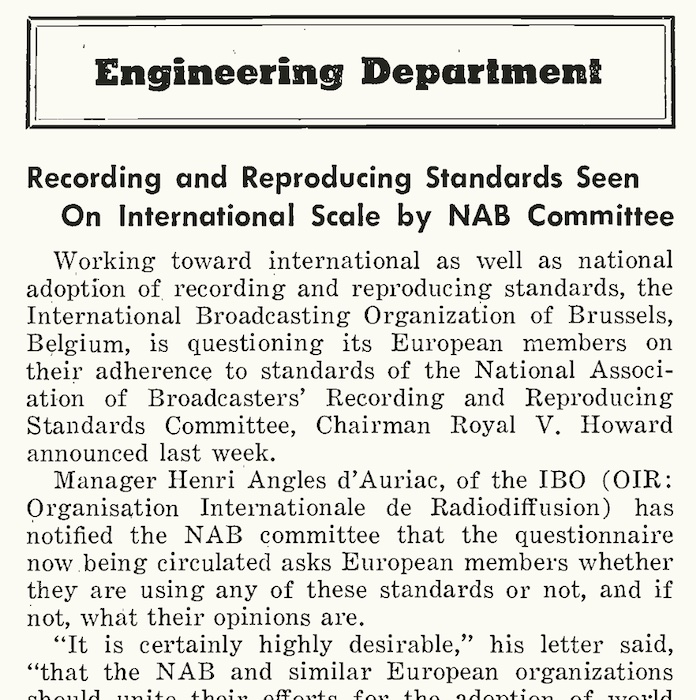
source: “NAB Reports, Vol.15, No.50, December 15, 1947”, p.1016
ベルギーの IBO (国際放送機構) が、欧州の各局に NAB 規格準拠の意思があるか問い合わせをしたことを伝える記事
Recording and Reproducing Standards Seen On International Scale by NAB Committee
NAB委員会が録音・再生標準規格の国際化を検討
Working toward international as well as national adoption of recording and reproducing standards, the International Broadcasting Organization of Brussels, Belgium, is questioning its European members on their adherence to standards of the National Association of Broadcasters’ Recording and Reproducing Standards Committee, Chairman Royal V. Howard announced last week.
国際的にも、国内的にも録音・再生標準規格の採用を目指すべく作業が行われているが、議長の Royal V. Howard 氏のアナウンスによると、ベルギーのブリュッセルにある国際放送機構 (International Broadcasting Organization) は欧州のメンバに対し、NAB録音・再生規格委員会の定めた標準規格に準拠しているか質問したとのことである。
Manager Henri Angles d’Auriac, of the IBO (OIR: Organization Internationale de Radiodiffusion) has notified the NAB Committee that the questionnaire now being circulated asks European members whether they are using any of these standards or not, and if not, what their opinions are.
IBO (国際無線通信機構) のマネージャ、Henri Angles d’Auriac 氏は、「(米国NABの)規格を使っているか」「使っていない場合は、どのような意見があるか」を尋ねるアンケートが現在欧州のメンバに回されているところである、と NAB 委員会に通達した。
“It is certainly desirable,” his letter said, “that the NAB and similar European organization should unite their efforts for the adoption of world standards for electrical transcriptions and recordings, such standards being necessary to the exchange of programs internationally on a wider scope.”
d’Auriac 氏の書簡によると、「(米国の)NAB、および欧州の同様の機関が、トランスクリプション盤とその録音についての世界標準を策定する努力をすべく協力することが確かに望ましい。なぜなら、そのような国際標準の策定によって、より広い範囲での国際的な番組の交換のために必要なものだからだ」とされた。
The European action was a result of work undertaken by the committee at its Atlantic City meeting, during the NAB convention.
この欧州における行動は、NAB の大会期間中に開催された、アトランティックシティでの委員会の作業の成果であった。
NAB Reports, December 15, 1947, Vol.15, No.50, p.1016欧州の各機関や各レーベルとも連携して、将来的には国際的な統一規格を作り上げたい、という話が、ここでも繰り返されています。
Strong desire for the future adoption of some international standards, in close liaison with European organizations and labels, is expressed here again.
Another result of the Atlantic City meeting was the formation of an executive committee composed of Robert M. Morris, of NBC, chairman; W.S. Bachman, Columbia Records, Inc.; Dr. S.J. Begun, Brush Development Co.; Howard A. Chinn, CBS; John D. Colvin, ABC; George M. Nixon, NBC; C.R. Sawyer, Western Electric; H.I. Reiskind, RCA-Victor; and K.R. Smith, Muzak Corp.
アトランティックシティでの委員会のもうひとつの成果として、以下のメンバで構成される執行委員会の結成が挙げられる。Robert M. Morris (NBC, 議長)、 W.S. Bachman (Columbia)、 Dr. S.J. Begun (Brush Development)、 Howard A. Chinn (CBS)、 John D. Colvin (ABC)、 George M. Nixon (NBC)、 C.R. Sawyer (Western Electric)、 H.I. Reiskind (RCA Victor)、 K.R. Smith (Musak)。
Chairman Morris announced at the first meeting of the executive committee that three members of the NAB committee will work with the American Standards Association’s sectional committee on standards for sound recording. This ASA committee, sponsored by I.R.E., S.M.P.E., and NAB, will try to establish standards for interchangeability and performance of all types of sound recording and reproducing equipment.
Morris 議長は、第1回執行委員会において、NAB委員会の3名がアメリカ規格協会 (American Standards Association, ASA) の録音規格委員会に協力することを発表した。この ASA 委員会は、I.R.E.(米国無線学会)、S.M.P.E.(米国映画技術者協会)、NAB(全米放送事業者協会)がスポンサーしており、あらゆる種類の録音・再生機器の互換性と性能に関する規格を確立しようとしている。
NAB Reports, December 15, 1947, Vol.15, No.50, p.1016アメリカ規格協会 (ASA) の話も出てきています。大戦後であるこの時期は、ディスク録音再生、磁気録音再生に限らず、産業界・工業界のあらゆる規格の標準化作業が積極的に行われていたことを表すエピソードといえそうです。
The name of ASA (American Standards Association) appears here. I guess that many activities and works were conducted toward the standardization for various industry and technology, especially after the WWII.
Projects Assigned. The executive committee meeting assigned projects to nine working groups to study recorded groove shape and reproducer stylus contour, distortion, signal-to-noise ratio, and recorded level, recording characteristics, magnetic recording, reproducing turntable diameter, height, torque, speed and “wow”, and concentricity of record center hole, frequency response characteristics of disc reproducers and equalizer combinations, tracking error of disc reproducers, and vertical force of disc reproducers, lacquer recording blanks (except those characteristics covered by other groups), disc tone record and translation loss, glossary of terms and definitions and symbols.
割り当てられたプロジェクト: 執行委員会会合では、以下のプロジェクトを9つのワーキンググループに割り当てた。記録溝の形状、再生針の形状、歪み、S/N比、録音レベル、録音特性、磁気テープ録音、再生ターンテーブルの直径、ターンテーブルの高さ、ターンテーブルの速度、ターンテーブルの「ワウ」、レコードのセンターホールの同心性、カートリッジとイコライザの組み合わせによる周波数応答特性、トラッキングエラー、針圧、ラッカー盤(記録特性は除く)、トーン(テスト)レコードと変換ロス、用語解説と定義、記号。
The executive committee’s next meeting is tentatively scheduled for late January, by which time the group is to have reviewed existing standards and prepared to vote on their retention or modification.
次回の執行委員会は1月下旬に予定されており、それまでに既存の規格を見直し、規格をそのまま維持するか、それとも変更するか、の投票に向けて準備を行うことになっている。
The committee has also agreed that all future standards will consist of three parts: definition, minimum standards, and method of measurement.
また、全ての規格は今後、「定義」「最低標準規格」「測定方法」の3つのパートで構成されることに合意がなされている。
NAB Reports, December 15, 1947, Vol.15, No.50, p.101610.1.5 1948-1949 issues of NAB Reports…?
不思議なことに、1948年を通じて数多く行われたであろう、1949年NAB標準規格改訂・追加項目策定の会合や作業に関する情報が、全く見つかりません。さらに、NAB Reports 誌自体も、1948年3月15日号を最後にオンラインでは見つけられません。
Strangely enough, I cannot find any information on the standardization work that was conducted throughout the year 1948. Furthermore, March 15, 1948 issue of the NAB Reports is the last one I could find online.
多くの NAB Reports を Internet Archive 上に提供してくれている、メリーランド大学カレッジパーク校に問い合わせてみたところ、以下の情報を教えてもらいました。担当の James Michael Baxter さん、ありがとうございます。
I contacted to the University of Maryland College Park, that provided the digital scans of many issues of the NAB Reports to the Internet Archive, and I got the following information – thank you so much James Michael Baxter-san!
“NAB Reports” continued until February 1949. Then as “NAB Member Service,” the publication continued from March 1949 to 1966.
「NAB Reports」誌は1949年2月まで発行が続き、その後誌名を「NAB Member Service」と変更し、1949年3月から1966年まで発行された。
“NAB Highlights” was published from 1958 to 1985. “NAB Today” was published from 1985 to 1996 under several titles, “NAB Today Radio,” “Radio Week,” and “NAB Today Television.”
その他、「NAB Highlights」誌が1958年から1985年まで発行された。その後「NAB Today」誌が1985年から1996年まで発行されたが、「NAB Today Radio」「Radio Week」「NAB Today Television」などさまざまなタイトルで出されていた。
The focus of these later titles may be slightly different from “NAB Reports.”
これら(NAB Reports 誌の後継である)各種刊行物は、元の「NAB Reports」とは扱う内容が若干異なっていたと思われる。
quoted from the email writtenby Mr. James Michael Baxter to me on January 6, 2023後日、Broadcasting Telecasting 誌 1949年2月21日号に「現在の NAB Reports を全面的に見直す」「各部門向けに NAB Member Service という機関誌を発行する」と掲載されているのを見つけました。
Later I found the news in the Broadcasting Telecasting magazine Feb. 21, 1949 issue, that reads: “a plan to revamp completely the present NAB Reports to the membership”, and “All departmental bulletins (…) known as NAB Member Service”.
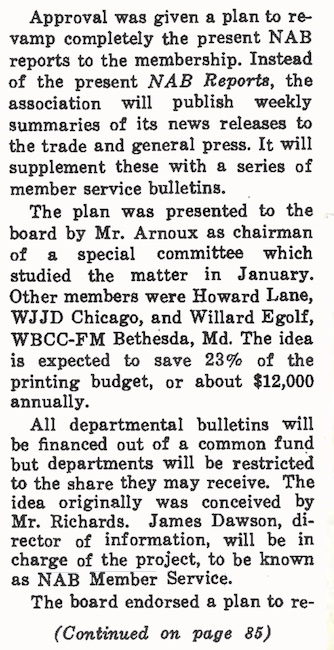
source: Broadcasting Telecasting, Vol.36, No.8, p.83.
NAB録音・再生規格委員会における、ディスク録音再生に関するその後の動きを伝える資料は、かろうじて次節で紹介する Broadcasting Telecasting 誌の1949年3月28日号と4月4日号にみることができます。ただし、今までみてきたような「高域プリエンファシスを下げるかどうか」といった技術的な議論については特に言及がないことから、1942年規格の16項目はそのまま生かした上で、1942年には策定できなかった残りの項目の策定を急いだ、ということなのかもしれません。
The subsequent work by NAB Recording and Reproducing Standards Committee barely appears on the Broadcasting Telecasting magazine, namely Mar. 28, 1949 and Apr. 4, 1949 issues. However, these reports does not mention any technical discussion on “decreasing high-frequency pre-emphasis”. I guess the committee rushed to adopt the revised standards, using sixteen standard items already adopted in 1942, and discussing and adopting additional items.
これには、大きく2つの理由が考えられます。
I guess two factors prevented the Committee from revising the recording characteristics.
まず1つ目、現場投入が急速に進んできた磁気テープの存在があげられると考えられます。磁気テープについても、業界内での録音・再生標準規格の策定を急ぐべく、そちらの作業に忙殺されていたのでしょう。
One thing would be the advent of magnetic wire/tape recording system: the Committee might be very busy formulating recording / reproducing standards for magnetic recorders in the broadcast industry.
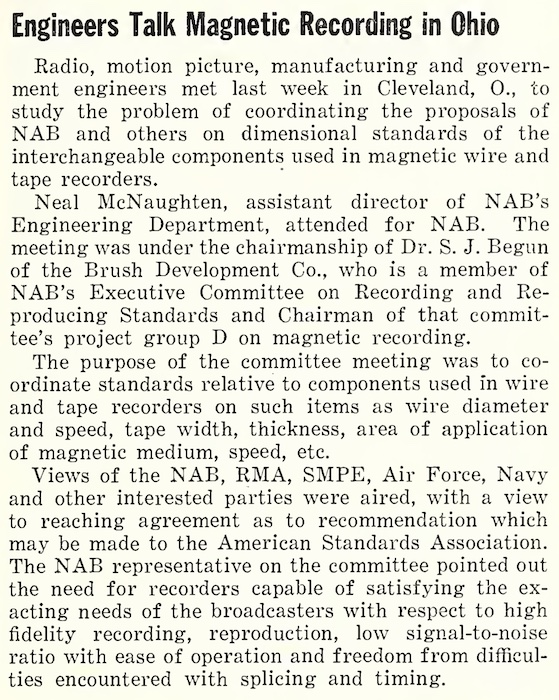
source: “NAB Reports, Vol.16, No.7, February 16, 1948”, p.125
1948年2月に開催された、磁気ワイヤーおよび磁気テープの会合を伝える記事。NAB、RMA (Radio Manufacturers Association)、SMPE (Society of Motion Picture Engineers)、空軍、海軍などから意見を徴収し、ASA(米国規格協会、現在の ANSI = 米国国家規格協会)に提出する勧告の合意を目指すとする。
ディスク録音の規格については、1947年時点であれだけ「1942 NAB の高域プリエンファシスは強すぎる」という議論が巻き起こっていたのですから、今後もそのままで良いという判断にはなってなかったはずです。しかし、暫定版とはいえ、1942年時点で既に16項目の標準規格が策定済みであり、追加項目の規格化を先に進めるべく、将来的に録音・再生特性を修正する含みを持たせた上で、トランスクリプション盤の規格改訂の検討を先送りした可能性が高いと考えることができそうです。
As we have seen above, many participants complained that “high frequency pre-emphasis of 1942 NAB is too much”. So many engineers shared the idea of decreasing the pre-emphasis in the future. However, the Committee needed to formulate and adopt many more items, along with the already adopted sixteen standard items. So highly probably the Committee procrastinated the revision work of the recording/reproducing characteristic.
そして、考えうる2つ目の理由は、のちのブログ記事で詳しくみていきますが、1948年6月に大々的に発表された、Columbia の 市販用 LP (Long Playing Microgroove) レコードの発表 でしょう。
And the other thing would be, as we will see later in the following article, the advent of Columbia’s LP (Long Playing Microgroove) commercial records, with a big announcement in June 1948.
ご存知の通り、Columbia がこの市販向け新しいメディアに当初採用した録音再生カーブは、1942年NABカーブの修正版(重低域ターンオーバーが異なる)でした。Columbia がこのカーブを採用した理由は、ほぼ間違いなく放送局(プロフェッショナル市場)で当時標準規格であった NABカーブ(すなわち Orthacoustic カーブ)を念頭に置いたからでしょう。
As you may know, the recording characteristic for the new disc medium by Columbia was a modified version of the 1942 NAB curve (with a different bass turnover characteristic). Columbia surely adopted their own new curve, with the industry-standard NAB (thus Orthacoustic) curve in their mind.
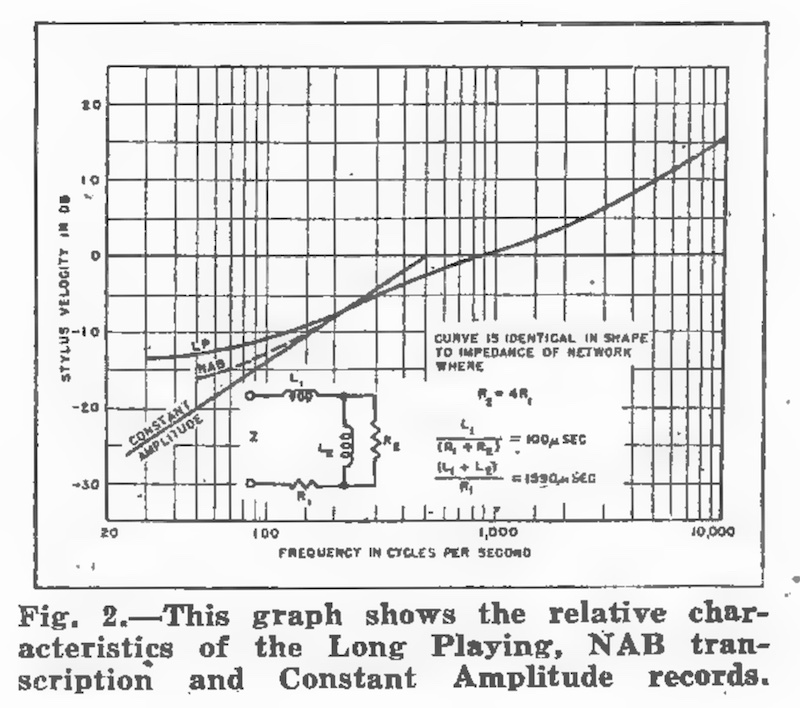
source: “A Technical Survey of Latest Overseas Developments: NEW LONG PLAYING RECORDS”, Radio Science (Australia), Vol.1, No.10, Nov.-Dec., 1948, p.15.
オーストラリアの雑誌の Columbia Long Playing Microgroove レコード紹介記事に掲載された NAB / Columbia 録音カーブのグラフ
NAB(全米放送事業者協会)や全米の放送局としては、トランスクリプション盤も、市販の新しいレコードも、(低域プリエンファシスが異なるとはいえ)同じ装置でおおよそ問題なく再生できることは、大きなメリットになるからです。だから、この1949年NAB規格改訂のタイミングでは、トランスクリプション盤向けのNABカーブ改訂を保留した、という可能性があります。
For NAB and broadcast stations, similarity (or quasi-match) of the two characteristics gives a great advantages, playing both discs with the same playback equipment (although the low pre-emphasis is slightly different). This would possibly be the reason NAB remained the recording characteristic unmodified in 1949.
さらに、録音・再生規格執行委員会のメンバには、当然ながら Columbia のエンジニアも含まれていました。なんらかの影響があったと考えられる気もします。
Furthermore, NAB’s Recording and Reproducing Executive Committee contained an engineer from Columbia, with keeping the advent of LP confidential. So the unmodified characteristic (from 1942 to 1949) may be the result of Columbia’s involvement somehow.
10.1.6 Broadcasting Telecasting, March 28, 1949
そのような類推を念頭において、以下の Broadcasting Telecasting 1949年3月28日号の記事を読むと、やはり磁気テープに関する話題がほとんどを占めているのがみてとれます。
With such analogical inference in mind, let’s read the following article in the Broadcasting Telecasting magazine, March 28, 1949 issue. Again, the primary topic is the standardization of magnetic recording.
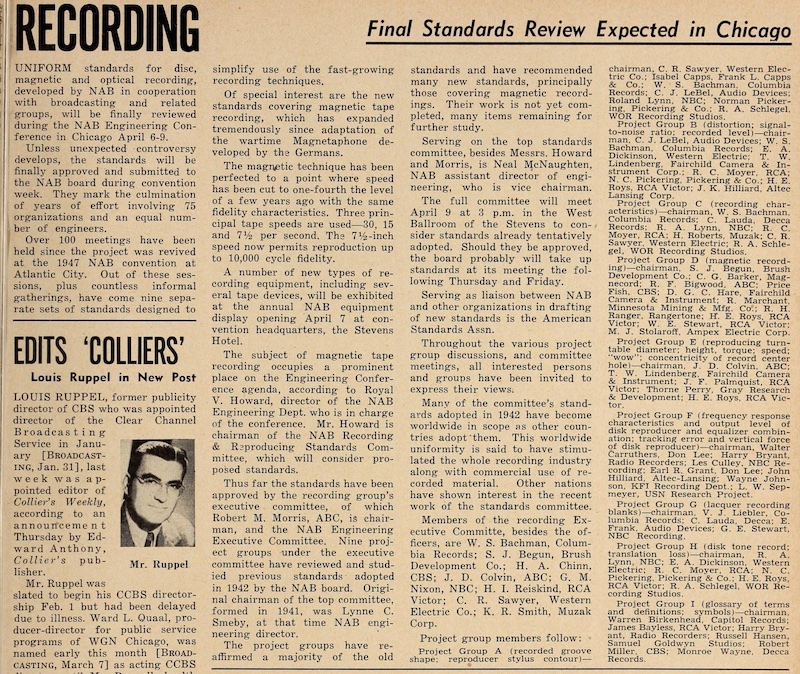
source: Broadcasting Telecasting, Vol.36, No.13, March 28, 1949, p.29
トランスクリプション盤レコード、磁気録音、光学録音の統一規格が4月6-9日開催のNAB技術カンファレンスで採択される見通し、と伝える記事
UNIFORM standards for disc, magnetic and optical recording, developed by NAB in cooperation with broadcasting and related groups, will be finally reviewed during the NAB Engineering Conference in Chicago April 6-9.
NAB が放送局や関連団体と協力して策定したディスク録音、磁気録音、光学録音に関する統一規格が、4月6日〜9日にシカゴで開催されるNAB技術カンファレンスで最終審査を迎える。
Unless unexpected controversy develops, the standards will be finally approved and submitted to the NAB board during convention week. They mark the culmination of years of effort involving 75 organizations and an equal number of engineers.
予期せぬ論争が起こらない限り、この規格は最終的に承認され、大会期間中にNAB理事会に提出される予定となっている。この規格は、75の団体および同数のエンジニアが参加し長年を費やした努力の集大成となる。
Over 100 meetings have been held since the project was revived at the 1947 NAB convention at Atlantic City. Out of these sessions, plus countless informal gatherings, have come nine separate sets of standards designed to simplify use of the fast-growing recording techniques.
1947年にアトランティックシティで開催されたNAB年次大会以来、100回以上の打ち合わせが催された。これらの会合、および数えきれないほどの非公式な打ち合わせの結果、急成長する録音技術の使用を簡素化するべく設計された9つの独立した規格が生まれた。
Broadcasting Telecasting, Vol.36, No.13, March 28, 1949, p.291947年9月〜1949年3月に、NAB 録音・再生規格委員会、およびそれに準ずる会合が100回以上も行われていたのはびっくりです。これら全ての議事録が存在するのであれば、ぜひ読んでみたいところではあります。
I feel so surprized to know that over 100 meetings had been held from September 1947 to March 1949. If all the meeting minutes existed, I would love to read all of them.
Of special interest are the new standards covering magnetic tape recording, which has expanded the wartime Magnetaphone developed by the Germans.
特に注目されるのは、磁気テープ録音に関する新しい規格で、これは戦時中にドイツが開発したマグネトフォンを発展させたものとなる。
The magnetic technique has been perfected to a point where speed has been cut to one-fourth the level of a few years ago with the same fidelity characteristics. Three principal tape speeds are used – 30, 15 and 7 1/2 per second. The 7 1/2-inch speed now permits reproduction up to 10,000 cycle fidelity.
磁気録音技術は、同じ忠実度特性で(テープの)速度を数年前の4分の1にまで落とすところまで完成してきた。主たるテープ速度は、30インチ/秒、15インチ/秒、7.5インチ/秒の3種である。7.5インチ/秒では 10,000Hz までの忠実再生が可能になった。
A number of new types of recording equipment, including several tape devices, will be exhibited at the annual NAB equipment display opening April 7 at convention headquarters, the Stevens Hotel.
4月7日から大会本部のスティーブンスホテルで開催される NAB 機器展示会では、テープ装置をはじめとする多くの新型録音機材が展示される予定である。
The subject of magnetic tape recording occupies a prominent place on the Engineering Conference agenda, according to Royal V. Howard, director of the NAB Engineering Dept. who is in charge of the conference. Mr. Howard is chairman of the NAB Recording & Reproducing Standards Committee, which will consider proposed standards.
会議の責任者であるNAB技術ディレクタの Royal V. Howard 氏によると、磁気テープ録音の議題は本技術会議の中でも重要な位置を占めているという。Howard 氏は、規格案を検討する NAB 録音・再生標準化委員会の委員長を務めている。
Thus far the standards have been approved by the recording group’s executive committee, of which Robert M. Morris, ABC, is chairman, and the NAB Engineering Executive Committee. Nine project groups under the executive committee have reviewed and studied previous standards adopted in 1942 by the NAB board. Original chairman of the top committee, formed in 1941, was Lynne C. Smeby, at that time NAB engineering director.
Broadcasting Telecasting, Vol.36, No.13, March 28, 1949, p.29やはり1949年新規格の目玉だけあって、テープ録音に関する規格の話が説明されています。
Standards of Magnetic Recording is described in detail, as this was the primary topic in the 1949 Standards.
これまでのところ、本規格はすでに、ABC の Robert M. Morris 氏が委員長を務める録音・再生規格執行委員会と、NABエンジニアリング執行委員会によって承認を得ている。執行委員会の下にある9つのプロジェクトグループは、1942年に採択された前回の規格を精査し、調査研究を進めてきた。ちなみに、1941年に設置された委員会の初代委員長は、当時NAB技術ディレクタであった Lynne C. Smeby 氏であった。
The project groups have re-affirmed a majority of the old standards and have recommended many new standards, principally those covering magnetic recordings. Their work is not yet completed, many items remaining for further study.
全プロジェクトグループは、旧規格の大部分を再確認・再承認した上で、磁気テープ記録に関する規格を中心として多くの新規格項目を推奨している。この作業プロジェクトはまだ完了してはおらず、多くの項目が今後の検討課題として残っている。
Serving on the top standards committee, besides Messrs. Howard and Morris, is Neal McNaughten, NAB assistant director of engineering, who is vice chairman.
Howard、Morris 両氏と共に録音・再生規格委員会をとりまとめているのは、NAB技術部門アシスタントディレクタである Neal McNaughten氏であり、彼が副委員長を務めている。
The full committee will meet April 9 at 3 p.m. in the West Ballroom of the Stevens to consider standards already tentatively adopted. Should they be approved, the board probably will take up standards at its meeting the following Thursday and Friday.
Broadcasting Telecasting, Vol.36, No.13, March 28, 1949, p.29上述のように、委員会についての説明が書かれたあと、米国規格協会と連携していること、そしてこの規格策定作業が世界的な注目を集めていること、について説明があります。
After the description of the Committee itself as we see above, the articles mentions the close relationship with ASA, as well as the work gaining international interest.
委員会は4月9日午後3時より、スティーブンスホテルのウェストボールルームで開催され、すでに暫定的に採択された標準規格を検討する予定となっている。その場で承認された場合、NAB理事会はおそらく翌週の木曜日および金曜日の会合でこの標準規格に関する議題を取り上げることになる。
Serving as liaison between NAB and other organizations in drafting of new standards is the American Standards Assn.
NABと他団体との間で、新規格の連携役を担っているのは、米国規格協会 (American Standards Association) である。
Throughout the various project group discussions and committee meetings, all interested persons and groups have been invited to express their views.
プロジェクトグループでの議論、そして委員会会合を通じて、本件に関する全ての利害関係者や団体を招き、意見を求めてきた。
Many of the committee’s standards adopted in 1942 have become worldwide in scope as other countries adopt them. This worldwide uniformity is said to have stimulated the whole recording industry along with commercial use of recorded material. Other nations have shown interest in the recent work of the standards committee.
1942年の暫定規格は、他国での採用事例もあり、世界的な広がりをみせるようになっている。この世界的な規格統一は、録音物の商業的利用とともに、録音業界全体を活性化させたと言われている。本録音・再生規格委員会の動きには、他の国々も関心を示しているところである。
Members of the recording Executive Committee, besides the officers, are W.S. Bachman, Columbia Records; S.J. Begun, Brush Development Co.; H.A. Chinn, CBS; J.D. Colvin, ABC; G.M. Nixon, NBC; H.I. Reiskind, RCA Victor; C.R. Sawyer, Western Electric Co.; K.R. Smith, Musak Corp.
録音・再生規格執行委員会のメンバは以下の通りである。 W.S. Bachman (Columbiaレコード)、 S.J. Begin (Brush社)、 H.A. Chinn (CBS局)、 J.D. Colvin (ABC局)、 G.M. Nixon (NBC局)、 H.I. Reiskind (RCA Victorレコード)、 C.R. Sawyer (Western Electric社)、 K.R. Smith (Musakレコード)。
Broadcasting Telecasting, Vol.36, No.13, March 28, 1949, p.29その後、当該記事最後には、9つの分科会すべてのメンバが書かれています。長いですが、これも非常に興味深いので、引用します。多くのメンバが複数の分科会を掛け持ちしていることがわかります。
The last paragraph of this article lists all the members of the nine groups of the Committee. I will include the whole sentences below because it is very interesting, although it’s very long. As we can see, many members work in multiple groups.
また、RCA Victor / Columbia / Decca / Capitol などのレーベル、CBS / NBC / ABC / Don Lee などの放送局、Capps / Pickering などの録音再生針製造メーカ、Brush / Magnecord / Rangertone / Ampex などの磁気録音再生機器製造メーカ、Fairchild / Gray / Western Electric / RCA などのディスク録音再生機器製造メーカ、そして WOR / KFI / Radio Recorders などの録音スタジオ、などなど、全方位の関係者が標準規格策定作業に積極的に関わっていたこともみてとれます。
It is also interesting to see that almost all related companies were involved in the projects, including record manufacturers and labels (RCA Victor, Columbia, Decca, Capitol, etc.), broadcast stations (CBS, NBC, ABC, Don Lee, etc.), recording/reproducing stylus manufacturers (Capps, Pickering, etc.), magnetic recording/reproducing manufacturers (Brush, Magnecord, Rangertone, Ampex, etc.), disc recording/reproducing manufacturers (Fairchild, Gray, Western Electric, RCA, etc.), and recording studios (WOR, KFI, Radio Recorders, etc.).
Project group members follow:
プロジェクトグループのメンバは以下の通り。
Project Group A (recorded groove shape; reproducer stylus contour) – chairman, C.R. Sawyer, Western Electric Co.; Isabel Capps, Frank L. Capps & Co.; W.S. Bachman, Columbia Records; C.J. LeBel, Audio Devices; Roland Lynn, NBC; Norman Pickering, Pickering & Co.; R.A. Schlegel, WOR Recording Studios.
プロジェクトグループA (記録溝の形状、および再生針の形状) – 議長 C.R. Sawyer (Western Electric社)、Isabel Capps (Frank L. Capps社)、W.S. Bachman (Columbiaレコード)、C.J. LeBel (Audio Devices社)、Roland Lynn (NBC局)、Norman Pickering (Pickering 社)、R.A. Schlegel (WOR録音スタジオ)。
Project Group B (distortion; signal-to-noise ratio; recorded level) – chairman, C.J. LeBel, Audio Devices; W.S. Bachman, Columbia Records; E.A. Dickinson, Western Electric; T.W. Lindenberg, Fairchild Camera & Instrument Corp.; R.C. Moyer, RCA; N.C. Pickering, Pickering & Co.; H.E. Roys, RCA Victor; J.K. Hillard, Altec Lansing Corp.
プロジェクトグループB (歪、S/N比、録音レベル)- 議長 C.J. LeBel (Audio Devices社)、W.S. Bachman (Columbiaレコード)、E.A. Dickinson (Western Electric社)、T.W. Lindenberg (Fairchild社)、R.C. Moyer (RCA社)、N.C. Pickering (Pickering社)、H.E. Roys (RCA Victorレコード)、J.K. Hillard (Altec Lansing社)。
Project Group C (recording characteristics) – chairman, W.S. Bachman, Columbia Records; C. Lauda, Decca Records; R.A. Lynn, NBC; R.C. Moyer, RCA; H. Roberts, Muzak; C.R. Sawyer, Western Electric; R.A. Schlegel, WOR Recording Studios.
プロジェクトグループC (録音特性) – 議長 W.S. Bachman (Columbia レコード)、C. Lauda (Decca レコード)、R.A. Lynn (NBC局)、R.C. Moyer (RCA社)、H. Roberts (Muzak レーベル)、C.R. Sawyer (Western Electric 社)、R.A. Schlegel (WOR録音スタジオ)。
Project Group D (magnetic recording) – chairman, S.J. Begun, Brush Development, Co.; C.G. Barker, Magnecord; R.F. Bigwood, ABC; Price Fish, CBS; D.G.C. Hare, Fairchild Camera & Instrument; R. Marchant, Minnesota Mining & Mfg. Co.; R.H. Ranger, Rangertone; H.E. Roys, RCA Victor; W.E. Stewart, RCA Victor; M.J. Stolaroff, Ampex Electric Corp.
プロジェクトグループD (磁気録音) – 議長 S.J. Begun (Brush Development社)、C.G. Barker (Magnecord社)、R.F. Bigwood (ABC局)、Price Fish (CBS局)、D.G.C. Hare (Fairchild社)、R. Marchant (Minnesota Mining社)、R.H. Ranger (Rangertone社)、H.E. Roys (RCA Victorレーベル)、W.E. Stewart (RCA Victorレーベル)、M.J. Stolaroff (Ampex社)。
Project Group E (reproducing turntable diameter; height, torque; speed; “wow”; concentricity of record center hole) – chairman, J.D. Colvin, ABC; T.W. Lindenberg, Fairchild Camera & Instrument; J.F. Palmquist, RCA Victor; Thorne Perry, Gray Research & Development; H.E. Roys, RCA Victor.
プロジェクトグループE (再生用ターンテーブルの径、高さ、トルク、スピード、ワウ、センターホールの中心性) – 議長 J.D. Colvin (ABC局)、T.W. Lindenberg (Fairchild社)、J.F. Palmquist (RCA Victorレコード)、Thorne Perry (Gray社)、H.E. Roys (RCA Victorレコード)。
Project Group F (frequency response characteristics and output level of disk reproducer and equalizer combination; tracking error and vertical force of disk reproducer) – chairman, Walter Carruthers, Don Lee; Harry Bryant, Radio Recorders; Les Culey, NBC Recording; Earl R. Grant, Don Lee; John Hillard, Altec-Lancing; Wayne Johnson, KFI Recording Dept.; L.W. Sepmeyer, USN Research Project.
プロジェクトグループF (周波数応答特性、ディスク再生装置とイコライザの組み合わせによる出力レベル、トラッキングエラー、針圧) – 議長 Walter Carruthers (Don Lee局)、Harry Bryant (Radio Recordersスタジオ)、Les Culey (NBC録音スタジオ)、Earl R. Grant (Don Lee局)、John Hillard (Altec-Lancing社)、Wayne Johnson (KFI局録音部門)、L.W. Sepmeyer (USN研究プロジェクト)。
Project Group G (lacquer recording blanks) – chairman, V.J. Liebler, Columbia Records; C. Lauda, Decca; E. Frank, Audio Devices; G.E. Stewart, NBC Recording.
プロジェクトグループG (ラッカー録音盤) – 議長 V.J. Liebler (Columbiaレコード)、C. Lauda (Deccaレコード)、E. Frank (Audio Devices社)、G.E. Stewart (NBC録音スタジオ)。
Project Group H (disk tone record; translation loss) – chairman, R.A. Lynn, NBC; E.A. Dickinson, Western Electric; R.C. Moyer, RCA; N.C. Pickering, Pickering & Co.; H.E. Roys, RCA Victor; R.A. Schlegel, WOR Recording Studios.
プロジェクトグループH (テストレコード、転送ロス) – R.A. Lynn (NBC局)、E.A. Dickinson (Western Electric社)、R.C. Moyer (RCA社)、N.C. Pickering (Pickering社)、H.E. Roys (RCA Victorレコード)、R.A. Schlegel (WOR録音スタジオ)。
Project Group I (glossary of terms and definitions; symbols) – chairman, Warren Birkenhead, Capitol Records; James Bayless, RCA Victor; Harry Bryant, Radio Recorders; Russell Hansen, Samuel Goldwyn Studios; Robert Miller, CBS; Monroe Wayne, Decca Records.
プロジェクトグループI (用語集、定義、記号) – 議長 Warren Birkenhead (Capitolレコード)、James Bayless (RCA Victorレコード)、Harry Bryant (Radio Recordersスタジオ)、Russell Hansen (Samuel Goldwynスタジオ)、Robert Miller (CBS局)、Monroe Wayne (Deccaレコード)。
Broadcasting Telecasting, Vol.36, No.13, March 28, 1949, p.2910.1.7 Broadcasting Telecasting, April 4, 1949
同じく Broadcasting Telecasting 誌の翌号、1949年4月4日号では、開催を2日前に控えた NAB 年次総会特集と化した紙面となっています。
The next issue of the same Broadcasting Telecasting magazine – April 4, 1949 issue – is like a special issue of NAB Annual Meeting that would be held two days after the issue.
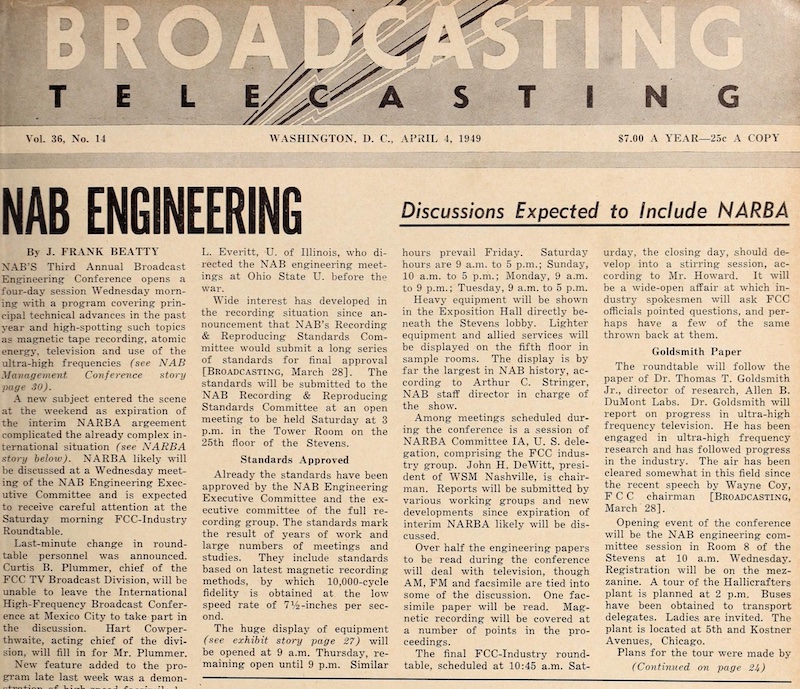
source: Broadcasting Telecasting, Vol.36, No.14, April 4, 1949, p.23
4月6-9日開催のNAB技術カンファレンスにおける標準規格策定の見通しを伝える記事
その誌面では、ディスクや磁気テープに関するNAB標準規格が無事採択される予定であることが報告されています。やはり、ディスク録音、特に録音カーブについての記載は特にありません。
The article reports that the revised NAB Standards (of disc/magnetic recordings) being successfully adopted. Again, no mention about disc recording, especially about disc recording characteristics.
Wide interest has developed in the recording situation since announcement that NAB’s Recording & Reproducing Standards Committee would submit a long series of standards for final approval [BROADCASTING, March 28]. The standards will be submitted to the NAB Recording & Reproducing Committee at an open meeting to be held Saturday at 3 p.m. in the Tower Room on the 25th floor of the Stevens.
NABの録音・再生規格委員会が、一連の長文からなる規格を最終承認のため提出する、と発表して以来、録音に関する状況には幅広い関心が集まっている(Broadcasting誌3月28日号を参照)。この規格は、土曜日の午後3時から、スティーブンスホテル25階のタワールームで開催される公開会議において、NAB録音・再生規格委員会に提出される予定となっている。
Already the standards have been approved by the NAB Engineering Executive Committee and the executive committee of the full recording group. The standards mark the result of years of work and large numbers of meetings and studies. They include standards based on latest magnetic recording methods, by which 10,000-cycle fidelity is obtained at the low speed rate of 7 1/2-inches per second.
この規格は、すでにNAB技術部門の執行委員会、および録音・再生規格委員会によって承認済である。またこの規格は、長年にわたる努力と多くの会議、そして調査研究の成果でもある。当規格には、秒速7.5インチという低速で 10,000Hz までの記録が可能となる、最新の磁気記録方式に基づく規格も含まれている。
Broadcasting Telecasting, Vol.36, No.14, April 4, 1949, p.2310.2 Recording and Reproducing Standards (1949 NAB)
このように正式に採択された1949年版NAB録音・再生標準規格そのものは入手できていないのですが、幸い、Oliver Read 氏が出版した書籍 “The Recording and Reproduction of Sound” という書籍の補足として掲載されています。
I have not yet obtained the primary documentation, i.e. finally adopted 1949 revision of the “NAB Recording and Reproducing Standards” itself. But fortunately the Standards is included in the book “The Recording and Reproduction of Sound” as a supplement.
1942年NAB規格の16項目から大幅に項目数が増え、また録音機器側と再生機器側の規格も別々に規定されています。全体で4セクションあり、「1. ディスク録音再生規格」「2. 磁気テープ録音再生規格」「4. 用語集」と大ボリュームになっています(なぜか第3セクションが掲載されていませんが、おそらく光学録音に関するものを掲載するつもりだったのでしょう)。
So many items are added to the original 1942 NAB Standards that consists of sixteen items. It also defines the standards of recording devices and reproducing devices. The section 1 is “Mechanical Recording and Reproducing Standards”; section 2 being “Magnetic Recording and Reproducing Standards”; and section 4 “Glossary of Mechanical, Magnetic and Optical Terms and Definitions”. Section 3 is missing somehow in the Standards, but it may be “Optical Recording Standards” or the likes, that was probably postponed for the standardization.
では、肝心の、1949年改訂版NAB標準規格におけるディスク用録音カーブはどうでしょうか。
Well, then, what is defined in the disc recording standards section of the 1949 Standards, especially what is the recording/reproducing characteristics like?
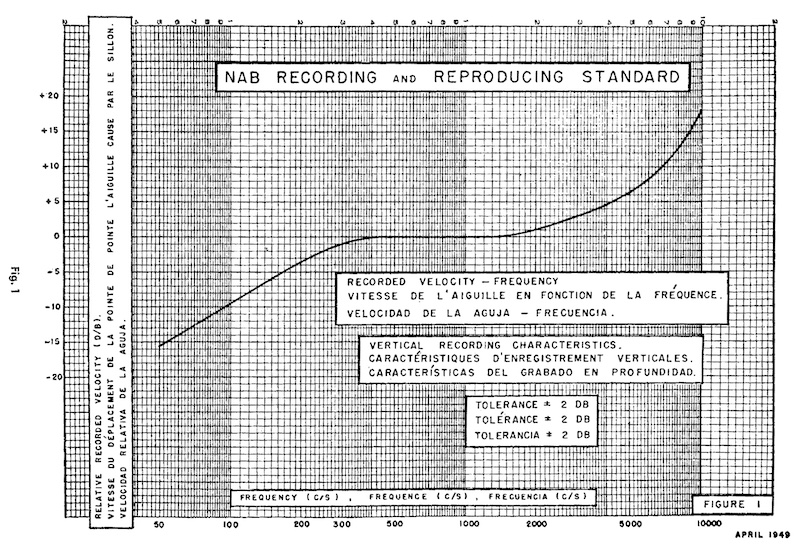
source: “The Recording and Reproduction of Sound”, Oliver Read, 2nd Edition, 1952, p.688
1949年NAB標準規格に掲載された、縦振動トランスクリプション盤用録音カーブのグラフ
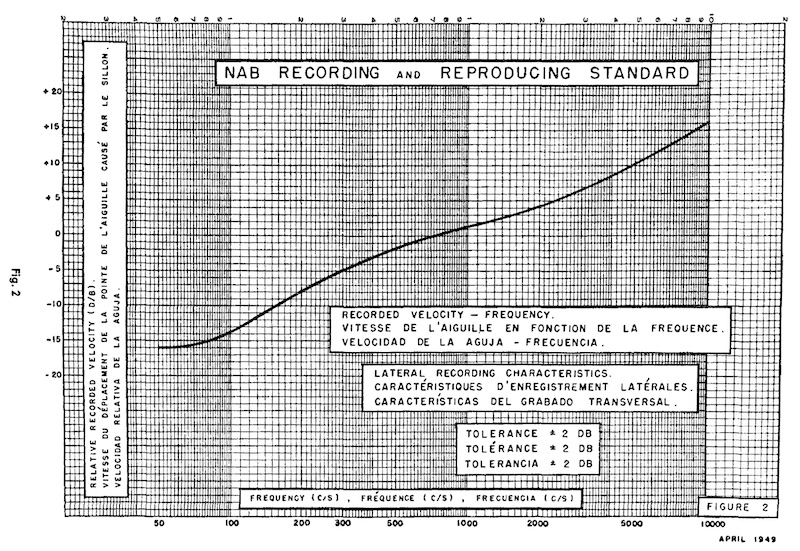
source: “The Recording and Reproduction of Sound”, Oliver Read, 2nd Edition, 1952, p.690
1949年NAB標準規格に掲載された、横振動トランスクリプション盤用録音カーブのグラフ
本稿 Pt.8 セクション 8.2 でみた、1942年の暫定規格の録音カーブのグラフと比較しても、特に何も変わっていません。また、パラメータの記載の追加もなく、単なるグラフとしての提示に留まっているのも同じです。グラフの描かれる周波数帯域も、50Hz〜10,000Hz であることまで同じです。
There is no difference between these 1949 recording curves (for lateral/vertical transcriptions) and the 1942 recording curves (as we have already seen in the Pt.8 Section 8.2 of my article). No parameters (like time constants) are still not specified here yet – just plotted graphs are provided. Also, the frequency ranges of the graphs are still 50Hz to 10,000Hz – like that of the 1942 graphs were.
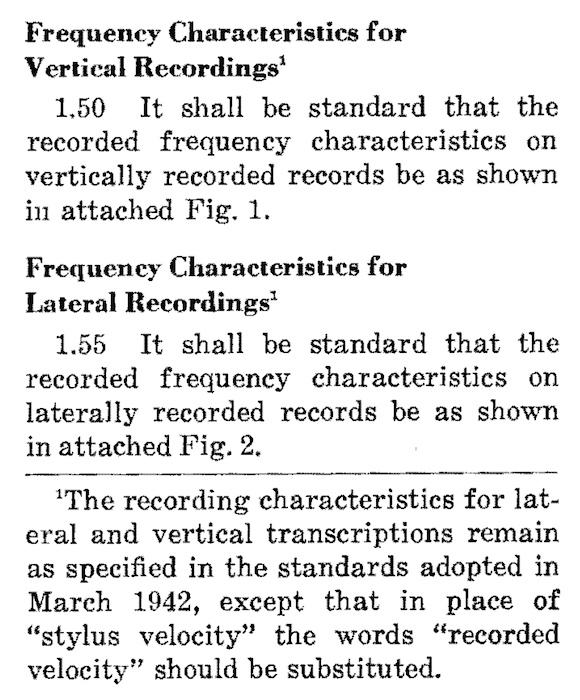
source: “The Recording and Reproduction of Sound”, Oliver Read, 2nd Edition, 1952, p.686
1949年NAB標準規格の縦/横振動トランスクリプション盤用録音特性説明部分
カーブは1942年版と同じ(“stylus velocity” の代わりに “recorded velocity” という表現に変わったのみ)と記載
It reads “recording characteristics (…) remain as specified in the standards adopted in March 1942”.
のちに 1954 RIAA となる、1953 NARTB 標準規格 の録音カーブでは、グラフは 下は 30Hz から上は 15,000Hz まで記載されています。
On the contrary, in the 1953 NARTB Standards (that would eventually become 1954 RIAA Standards), the plotted graph would be extended down to 30Hz, and up to 15,000Hz.
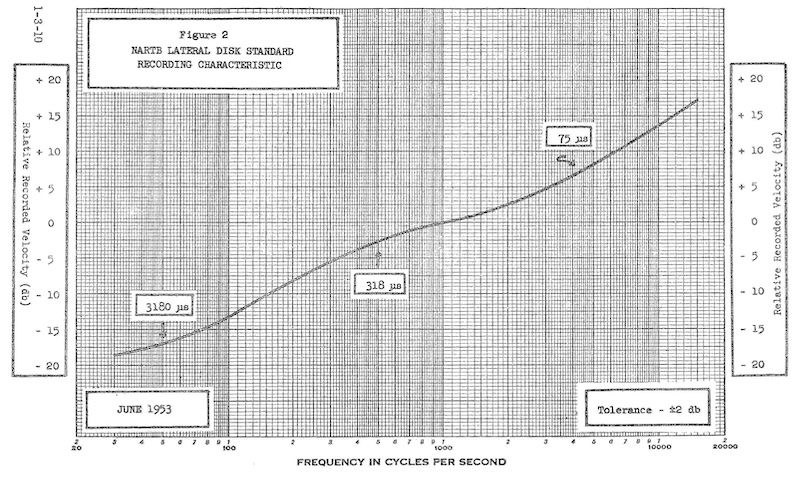
source: “Figure 2: NARTB Lateral Disk Standard Recording Characteristic”, Supplement No.2 to NAB (NARTB) Engineering Handbook (Fourth edition, 1949): NARTB Recording and Reproducing Standards (June, 1953), p. 1-3-10.
実はこの 15,000Hz まで描かれていることが、1942/1949 NAB カーブの高域プリエンファシスである +16dB at 10,000Hz (時定数 100μs) から、+13.7dB at 10,000Hz (75μs) に変更されたことと密接に関係していると考えます。この件についてはまた続編で紹介します。
In fact, the extention from 10,000Hz to 15,000Hz would highly probably relates closely to the decrease of high frequency pre-emphasis – from 1942/1949 NAB’s +16dB at 10,000Hz (time constant: 100μs), to 1953 NARTB (NAB)’s +13.7dB at 10,000Hz (75μs). I am going to describe this in the following part(s) of my entire article.
10.3 The summary of what I got this time / 自分なりのまとめ
なかなか肝心のRIAAカーブにまで到達できないまま(笑)本稿も Pt.10 まで到達してしまいました。
My entire article has already reached Part 10, although I have not yet reached the main point (RIAA Standards).
ともあれ、1949年改訂版NAB標準規格策定の背景を知ることで、マイクログルーヴLP時代突入後のカーブに関する多くのヒントを得ることができました。
Anyway, by studying the background history of the formulation of the 1949 revised NAB Standards, I have learned so many insights that will surely help understand the confusion (and the settlement) of the recording/reproducing characteristics after the advent of Long Playing Microgroove records.
さてさて、今回の内容をざっくりとまとめると、以下のようになるでしょうか。
…so, the rough summary of my understanding in this article would be something like this:
1942年暫定NAB規格は大戦中のため作業が中断したが、1947年から再び残る項目策定の作業が活発に行われた。
After the 1942 NAB Standards, the work had been suspended due to the wartime. But the work resumed in 1947 toward the adoption of the complete standards, discussing the rest of the standard items.
標準規格委員会の会合における議論の中で、1942年NAB標準規格の録音カーブは高域プリエンファシスが強すぎて、高域で歪みが多くなるため、改訂版規格ではプリエンファシスを弱めるべき、という意見が多数出されていた。しかも、具体的に、NABの100μsから、のちの1953年NARTB(すなわち 1954年 RIAA)と同じ75μsに下げるべきという意見が、1947年の議論の時点で出されていたことは特筆に値する。
During the Committe meetings and discussions, too much high-frequency pre-emphasis was critisized due to the distortion. Many engineers (committee members) claimed that the revised pre-emphasis should be lowered for better reproduction. Also, it is worthy of special mention that, even in 1947, many committee members claimed the 100μs pre-emphasis should be lowered to 75μs, that the 1953 NARTB Standards (thus 1954 RIAA Standards) would adopt a few years later.
1949年4月に開催されたNAB年次総会で標準規格委員会の会合が持たれ、改訂版NAB標準規格が承認された。業界で急速に普及しだした磁気テープ録音に関する規格策定がメインであった。一方、1942年暫定規格では承認が間に合わなかった、ディスク録音再生に関する追加項目も無事含められた。
NAB Recording and Reproducing Standards Committee meeting was held in April 1949, during the NAB Annual Meeting, and the revised 1949 Standards were adopted. The primary topic was the formulation of the standards for magnetic recording, that was rapidly diffused in the radio industry. Additional items for disc recording/reproducing, that were late for the tentative 1942 Standards, were also included in the 1949 Standards.
あれだけ高域プリエンファシスを下げるべきという議論が行われていたのに、1942年カーブがそのまま1949年カーブに引き継がれた。それは、磁気テープ録音規格の策定が急がれていたこと、そして、1949年NAB標準規格策定前の1948年6月に Columbia Long Playing Micgrogroove レコードが、1942年NAB録音カーブと類似したカーブを採用して登場したこと、が関係していると考えられる。
After all, the 1942 recording characteristics was carried over, kept unmodified, and adopted as a part of the 1949 NAB Standards, although there were some discussion on the “too much” high frequency pre-emphasis. This was highly probably because: (1) the Committee at the time was overwhelmed by busy works formulating the new recording medium – magnetic tape; and (2) before the final adoption of 1949 NAB Standards, Columbia proudly introduced the new type of disc medium for home use – LP (Long Playing Microgroove records), with very similar recording characteristics as 1942 NAB recording characteristics.
NAB標準規格委員会は、ASA(American Standards Association、アメリカ規格協会)とも連携し、各業界を通した規格策定を目指していたことが読み取れる。また、1947年の時点で、主に欧州の放送業界とも連携を始めており、トランスクリプション盤の世界的な規格統一を目指していたことも注目に値する。ただし、実際にそれが達成されるにはまだまだ時間を要した。
NAB Standards Committee, with the close relatonship with ASA (American Standards Association) that served as a liasion between NAB and other organization, aimed for the cross-industrial standardization. International standardization (of transcription records for broadcasting industry) was also kept in their mind, with frequent discussion with many stations, companies and organizations especially in Europe. However, it would took many more years until the standards were finally internationally uniformed.
次回 Pt.11 では、ついに、Columbia が満を持して発表した LP と、その録音特性についての話に入ります。
The next Pt. 11 will (finally!) deal with the Columbia’s LP and its recording characteristics.
» 続き / Sequel: “Things I learned on Phono EQ curves, Pt.11” »
